#switch back mongo
Explore tagged Tumblr posts
Text
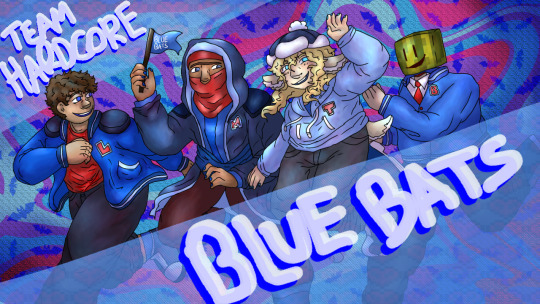
TEAM HARDCORE SWEEP !!!!!!
can’t believe one of my tumblr mutuals is in an mcc /silly
(version minus the front banner under the cut)

#legundo#switchbackmongo#taneesha#taneesha hogan#notnotbrock#not not brock#switch back mongo#dominioners#mccr#mcyt fanart#TEAM HARDCORE FUCKING SWEEEP BAYBEEEEEEEE#aceidiots art
118 notes
·
View notes
Text
LEARN MERN STACK? HERE IS EVERYTHING YOU NEED TO KNOW : June 19, 2024
Stack of technology provides MERN stack. It is a set of technologies used to develop an application, including programming languages, frameworks, databases, front-end and back-end tools, and APIs. In the MERN Stack, the working components are MongoDB, ExpressJS, ReactJS, and NodeJS.
Learn MERN Stack
Here are the details of the roles each component fulfills when developing a web application with the MERN stack :
MongoDB:
MongoDB is a NoSQL database that stores data as a document, comprising key-value pairs similar to JSON (JavaScript Object Notation) objects. MongoDB is flexible, letting users make schemas, databases, tables, and more. In MongoDB, special credentials identified by a primary key form its basic unit. After installing MongoDB, users can utilize the Mongo shell, which provides a JavaScript interface for interacting with the database, such as querying, updating, and deleting records.
Express.JS
Express is a framework used for making the back-end of web applications with Node.js. It makes coding easier compared to using Node.js alone by providing shortcuts and tools. With this framework, developers can create better web applications and APIs. It also offers many add-ons, called middleware, to make coding quicker and simpler. Instead of writing all the server code from scratch with Node.js, developers use Express to speed up the process. It is known for being fast and organized, and it offers lots of extra features through plugins.
ReactJS
React is a JavaScript library that is used for building user interfaces. React is used for the development of single-page web applications, complex software applications, and mobile applications. React can switch rapidly changing data. React allows the client to code in JavaScript and create UI components. React is an open-source JavaScript library that can be used for creating views rendered in HTML. Unlike AngularJS, React is not a framework but a library.
Node.js
Node.js, in the beginning developed for Google Chrome and made open-source by Google in 2008, is a JavaScript runtime environment. It is designed for building scalable network applications and can run JavaScript code outside of a web browser. With Node.js, users can execute their code on servers without a browser. It comes with a node package manager, offering thousands of free packages (node modules) for download. Node.js works without an enclosing HTML page. Here, uses its module system, based on CommonJS, to combine multiple JavaScript files seamlessly.
Advantages of a MERN Stack Developer
One of the main advantages of the MERN stack is that developers use only JavaScript throughout the entire development process. JavaScript is a versatile programming language used for both client-side and server-side tasks. In contrast, when working with another full-stack setup that involves multiple programming languages, developers often face challenges in integrating them seamlessly. However, stack developers only need to be proficient in JavaScript and JSON.
The MERN Stack ecosystem is always a growing platform that receives regular updates with new tools and technologies, which are focused at improving the development processes. So, the demand never goes down. If you are interested in learning more about MERN Stack, be sure to check out the best MERN Stack training in India. Currently, the Srishti campus is the best training center in Kerala. There are a lot of online MERN Stack training centers available in Kerala.
0 notes
Photo

Shrek 2
“Shrek 2″ is often considered to be one of the greatest sequels of all time by some people... and those people would be correct.
Shrek and Fiona are happily enjoying their marriage until they’re invited to a royal ball by Fiona’s parents. Fiona and Donkey are excited to go, but Shrek is hesitant. He has a feeling that Fiona’s parents won’t really like him or accept the choices that Fiona has made. Still, he ends up going and gets caught up in a ploy crafted by the Fairy Godmother.
The first “Shrek” was content with delivering a simple, yet powerful story. It used the benefit of simplicity by crafting genuinely funny jokes and sharp commentary about the relentless push of conservatism from DreamWorks's clear rival. “Shrek 2″ is ambitious, if not anything else. It retains the same level of jokes and commentary and I dare say that it actually elevated those levels. There were so many moments that had me laughing out loud. A few notable jokes were the “Cops” parody, which is still relevant today, and the Starbucks joke which is just so good. While maintaining the same level of quality of jokes and commentary, “Shrek 2″ also does what every good sequel does and expands the scope of the first film. I love everything about the kingdom of Far Far Away. First off, the name is just top-notch. It effectively positions itself as the place that every fairy tale starts off mentioning. Making it a parody of Hollywood is just so damn clever. “Shrek 2″ also feels like a genuine continuation of the first film because it follows up on logical plot beats. In a franchise about being more realistic about our ‘happily ever afters’, of course, they should explore what the in-laws think. Of course, we follow up on Prince Charming who hasn’t learned the lessons of the first film. Speaking of Prince Charming, “Shrek 2″ delivers with its new characters. Every one of them just hits the mark. Doris The Ugly Stepsister was hilarious to me as a child. Mongo will always have a place in my heart. Puss In Boots was so popular that he got his own spin-off movies, one of which is gaining exceptionally great critical reception in theaters right now. And who could forget the Fairy Godmother? She’s such a fun villain because she gets to be the celebrity who gets to ham it up when the cameras are rolling, but then switches to an evil mob boss on the flip of a switch. Plus, she has an amazing singing voice. She performs a cover of “Holding Out For A Hero” and has the rare honor of exceeding the original as the definitive way of listening to the song. Jennifer Saunders really sounds like she’s having a blast in the role. The final climax of this film is one that sticks out in everyone’s mind. I think rightfully so because the action is high-octane, high-stakes, non-stop fun with great jokes and call-backs along the way. You truly feel like Shrek is running out of time because of the love potion Fiona’s about to drink and the effects of the potion he drank. I do think the twist was a bit predictable, but it was still executed in an ambiguous enough manner that it didn’t bother me one bit. All in all, this movie is a masterclass on how to make sequels. I know it’s a meme to call it the best sequel of all time, but there is some truth in that. I wouldn’t go as far as calling it the best, but I think it’s perfect for the “Shrek” franchise.
★★★★★
Rewatched on January 4th, 2023
#Shrek 2#May#2004#Comedy#Children's#Adventure#Fantasy#Animation#PG#Andrew Adamson#Conrad Vernon#Kelly Asbury#January 2023#5 stars
15 notes
·
View notes
Text
D&D Quotes Without Context
Revenge of CHAOTICA! edition
EPISODE 8 —THE PLOT THINNENS!— “There’s a warehouse in the district near this port where he’s seen a lot of Warforged around. And on top of that, lot of Imperial soldiers trying not to look like imperial soldiers.” Katt: “It’s the crew cuts and shined shoes, every time.” Thunderchild nods: “Oh yes, soldiers failing to not look like soldiers is usually a good sign that there's important government shit that needs to be either stolen or blown up.” “I do like to earn my reputation. A living client is a happy client.” "On the other paw, dead men leave no 1-star reviews.” “And an unhappy client neatly fills a shallow ditch.” GM: If you want to approach them give me a stealth check… Katt: *rolls a nat-20* GM: You are vengeance and the night. Moonpaw: *rolls a nat-11* GM: They don’t seem to notice you either. But with less being the night. GM OOC: [name] stop rolling twenties. Roll for damage. Kat roundhouse kicks him into a convenient dumpster….Katt stops, pulls him out of the dumpster to check him for keys, ID and wallet before dropping him back in. Fiver: "Ugh, racist elves, how stock." Moonpaw: "It's one thing to be an asshole. It's another level to carry around evidence.” Fiver: "Not only are they a faschy piece of garbage, they're a cliche faschy piece of garbage.” To be fair, along with humans, Swamp Elves are the rednecks of Mongo Space. "Always going on about how 'Swampworld will rise again'. Sure it will.” Like, Batman is not stealthing through the only door in the room. "What seems to be the officer, problem?” “Where did the Tabaxi come from?” "I dunno, yer mom?” Moonpaw's ears twitch again. "And the plan devolves to fighting, as usual.” “Okay…New rule. When I am doing undercover bad guy thing, no one is allowed to accompany me unless they are shorter than 3 feet tall.” GM: [name], have you ever played a non-horrible PC? Thunderchild: “Yup, someone out there (whether up or down is up for debate) is definitely playing a joke on me. I do not like encountering inferior fascist versions of people I know.” The lizardman was planning on convincing them to leave the army and start a soup kitchen on Dune. OOC: Okay now I feel bad. “But-then-they-won’t-be-the-rings-of-my-enemies-as-spoils-of-war.” OOC: (I'm like the Mike Nelson of the Group. I'm the responsible one on paper. but its like saying you're the older brother cause you were born five minutes sooner out of a set of triplets.) OOC: To be fair, they do make excellent off-the-cuff-NPCs. We should just keep running into weirdly similar trios as we adventure. OOC2: Our version of Dibbler. Fiver raids the fridge before heading up the stairs to the next level. GM: They have Nuka Cola Orange. "I-will-try-to-read-their-lips. Wait. Circles-dont-have-lips..." “Now you nincompoop!” “Fiver-is-no-kind-of-poop..." Fiver clutches his chest and holds out his rabbits foot "May the Black Rabbit steal your fruity cereals.” “Gah! Assassins! You’ll not catch Doctor Nivasi unaware!” And then he pulls out a remote and flees into an escape pod that he of course had. Thunderchild: “So now we switch to plan: kill everything hostile, steal everything not nailed down and then light a fire on the way out?” "I always wanted to depreciate a mad scientist’s car.” Thunderchild: “Okay, first thing to do is stop hitting yourself.” Moonpaw: "Actual advice would be useful! I only know how to do the one thing!” Thunderchild: “Try not to die. I don't know why people expect me to have good advice to give in these situations.” “It's-a-double-sided-mirror! I-can’t-stab-it-without-stabbing-me!” "Fork, it's mounted on immovable rods!” OOC: Sudden twist. Trunky is a vampire. Well, technically only Moonpaw rolled high enough for that, but she’s only been sentient a week, so one of the others shouts it. Fiver: “It’s fine. SMASH THE FUCKER.” Thunderchild: "Like 70% chance she'll be fine.” GM: 60% at the worst! Thunderchild: “Worse comes to worse I'm an expert at fixing machines. And people.” Robbins: “Amber’s-going-to-become-a-distillery-isn’t-she?” Thunderchild: “I can build other things!” Amber: "Don't you even think about it! When I die I will become a blacksmith's forge, no still for you.” However, it’s at this point you see the screen behind where the mirror was showing the number 14. 13. 12. "What's that for?" Moonpaw goes up to the screen. Robbins: “I-think-it’s-bluffing.” Thunderchild: “If that had not exploded we would have looked really silly.” “Folks, I’m guessin’ that’s where we’re headed,” Tango says, pointing to an immense space station, like a factory complex in space. “Thats-no-moon..." "It isn't obvious?” OOC: Eggman...The Fastest Thing Alive. OOC: Captain Thunderchild’s Militarized Still. The Distillery Artillery. OOC: Basically, yeah: you boil a thing with alcohol to catch the alcohol vapor and have more-concentrated alcohol.
5 notes
·
View notes
Text
“Cryptid Cove: Security”
“Uh, sir, did you see that?”
Jacob glances up from his magazine, an eyebrow cocked.
“See what?”
The intern stares back at him. His glasses are dense with condensation. Heavy breathing sends a stray blob of snot flying. Disbelief fits perfectly on his face, which is as young and dumb as it ought to be.
Jacob sighs, and kicks his swivel chair across the room. The wheels squeak in violent protest.
But he can’t hear them. Not over the thunder.
“What did you see?”
He leans over the steel desk, peering at the kid’s security terminal.
The intern clears his throat.
“Something just triggered the motion sensors in Paddock...”
Paddock-M.
Jacob can barely see the enclosure through the rain. A pit sits on screen. It is large and rectangular, with four floodlights erected in each corner. None of them have been turned on, though.
The darkness consumes everything. Only the dunes are visible, the sand painfully bright and white.
Big dunes. Small dunes. Dunes with knife-sharp crests. Dunes with flat crests. Dunes that don’t move. Dunes that do move, are moving, sliding down…
Jacob’s eyes go wide. He smiles, then flips a switch.
Light splits the night.
“Well, well, well…”
He slaps the intern on his back.
“I think it’s your lucky day, kiddo!”
“A-and why,” the kid mumbles. “Why is that?”
Jacob can’t help but laugh. A loud, cavernous sound as deep as the pit. It quickly fills the small security room.
“‘Cause you get to see Ol’ Mongo!”
#evanthenerd83's storytime#creative writing#original writing#cryptid cove#microfiction#scifi and fantasy#cryptids#march 2020
8 notes
·
View notes
Video
youtube
Cal Tjader feat. Carmen McRae - “Heat Wave” Swingin’ Jazz for Hipsters, Volume 2 Song released in 1982. Compilation released in 1997. Latin Jazz
Here’s a good summary of Cal Tjader, the most celebrated non-Latin Latin jazz musician of all time, provided by critic Richard S. Ginell:
Cal Tjader was undoubtedly the most famous non-Latino leader of Latin jazz bands, an extraordinary distinction. From the 1950s until his death, he was practically the point man between the worlds of Latin jazz and mainstream bop; his light, rhythmic, joyous vibraphone manner could comfortably embrace both styles. His numerous recordings for Fantasy and Verve and long-standing presence in the San Francisco Bay Area eventually had a profound influence upon Carlos Santana, and thus Latin rock. He also played drums and bongos, the latter most notably on the George Shearing Quintet’s puckishly titled “Rap Your Troubles in Drums,” and would occasionally sit in on piano as well.
Tjader studied music and education at San Francisco State College before hooking up with fellow Bay Area resident Dave Brubeck as the drummer in the Brubeck Trio from 1949 to 1951. He then worked with Alvino Rey, led his own group, and in 1953, joined George Shearing’s then hugely popular quintet as a vibraphonist and percussionist. It was in Shearing’s band that Tjader’s love affair with Latin music began, ignited by Shearing’s bassist Al McKibbon, nurtured by contact with Willie Bobo, Mongo Santamaria, and Armando Peraza, and galvanized by the ‘50s mambo craze. When he left Shearing the following year, Tjader promptly formed his own band that emphasized the Latin element yet also played mainstream jazz. Bobo and Santamaria eventually joined Tjader’s band as sidemen, and Vince Guaraldi served for a while as pianist and contributor to the band’s songbook (“Ginza,” “Thinking of You, MJQ”). Tjader recorded a long series of mostly Latin jazz albums for Fantasy from the mid-'50s through the early '60s, switching in 1961 to Verve, where under Creed Taylor’s aegis he expanded his stylistic palette and was teamed with artists like Lalo Schifrin, Anita O'Day, Kenny Burrell, and Donald Byrd. Along the way, Tjader managed to score a minor hit in 1965 with “Soul Sauce,” a reworking of Dizzy Gillespie/Chano Pozo’s “Guacha Guaro,” which Tjader had previously cut for Fantasy. Tjader returned to Fantasy in the 1970s, then in 1979 moved over to the new Concord Picante label, where he remained until his death.
That move to Concord Picante is where the story of Tajder’s album with jazz songstress, Carmen McRae, begins. See, throughout the 60s and 70s, Tjader tried expanding his palette some: there was an attempt to link Asian scales with jazz music; he tried jazz with rock backbeats; and he gave in to the fusion craze and added electronic instruments to his band. None of these things were received well by critics, and on top of that, jazz music on the whole was precipitously waning in popularity, taking a distant backseat to rock music.
But at the tail-end of the 70s, Carl Jefferson, the head of Concord Records, came along. Jefferson, who had started his company in 1973, was building a west coast jazz empire, scooping up proven musicians left and right, and giving them a place they could happily call their label home. And with his acquisition of Tjader, he launched a whole new Concord sublabel, Concord Picante, which brought Tjader back to his Latin sound. By 1980, Jefferson had signed Carmen McRae, too, originally pairing her up with Tjader’s former bandleader, George Shearing, for an album.
Then in 1982 came Heat Wave, a full-on collaboration between Tjader, Mcrae, and both of their backing bands. It was Jefferson’s and McRae’s idea to have them team up, but Tjader and McRae ended up butting heads, hard. An excerpt from Cal Tjader: The Life and Recordings of the Man Who Revolutionized Latin Jazz, written by S. Duncan Reid, quotes the album’s drummer, Vince Lateano, and a McRae cohort, Sonny Buxton:
“Everybody was a little apprehensive because Carmen was known to be outspoken. She could be hard on musicians. We all thought, ‘Auugh, what’s going to happen here?’ As it turned out, she loved our band and our concepts. But she and Cal didn’t get along very well. Cal wasn’t really feeling a hundred percent. He’d come in and kind of stumble through some stuff and she would get impatient; it would get tense.”
Buxton, who was invited to attend the first session, had prior experience working with Mcrae as a producer and booker in her company. He was aware of how difficult she could be. The main issue was that Tjader couldn’t read the chart for the first track. “Carmen didn’t let up. ‘How do you call yourself a musician?’ The harangue went on for a long period of time as Cal gradually worked out the tune.”
Eventually, a decision was made to have Tjader come back at a later date and overdub his lines. He did not see McRae again. “If you listen to Heat Wave,” concluded Lateano, “it’s really nice. I’m very proud to be on it. I’m a big Carmen McRae fan, so that made it very worthwhile for me.” Buxton agreed that the LP, which also features Ramon Banda (timbales and percussion) and Al Bent and Mike Heathman (trombone), was a high point for the two artists.
Four months before Heat Wave was released to the public, Cal Tjader died of a heart attack at age 56. The album contained some of his last known studio recordings. And yet, despite his passing, the hardened jazz press remained unimpressed with the album, questioning the efficacy of the one-off team-up between he and McRae.
But Heat Wave still had some glimmers of greatness, like its title track. Originally an Irving Berlin-written tune sung by Ethel Waters, “Heat Wave” had been covered a bunch of times before. However, the people at Concord thought Tjader and McRae’s cover was good enough to earn the album’s top billing. And they were right; the song is simply sensational. The tension that Tjader and McRae had had in the studio isn’t detectable here, as McRae’s light and effortless raspiness trades off with some sweet, horn-led inflations, eventually giving way to the song’s peak, which features a wonderfully layered section where Tjader’s ringing vibes and Mark Levine’s rich piano chords complement each other while Poncho Sanchez and Ramon Banda provide more layers of underlying rhythms.
Early 80s Latin jazz magic from one of the genre’s maestros, along with one of the greatest jazz singers of all time, Carmen McRae.
#latin jazz#jazz#jazz music#latin#latin music#80s#80s music#80's#80's music#80s latin jazz#80's latin jazz#80s jazz#80's jazz#80s latin#80's latin#80s latin music#80's latin music#music
1 note
·
View note
Text
Top Reasons to Choose MERN Stack Development For Your Next Project
MERN Stack Development: Important Facts to know
In Present era, Web applications are being used in almost every industry, providing an easy to access interface for users to interact with. Don’t wonder there are 200,000+ web developers currently in the USA! Front-end development frameworks like Angular.js, Node.js, and React.js have exterminated back-end frameworks in developing mobile apps and websites. Furthermore, with these technologies, we’ve been able to reduce code size and enhancing coding effectiveness. But because bespoke software application development trends and technology move so sharply, a developer must stay alongside of the most recent market developments. Only the MERN stack development is capable of fulfilling this.
Its UI execution, open-source nature, and simplicity of switching b/w customer and server all contribute to this. It aims to enhance the performance of an application as a whole.
MERN Stack Development: Overview
The MERN stack is a collection of robust technologies to build scalable master online apps. It comprises front-end, back-end, & database components. This set of tools enables the creation of user-friendly full-stack JavaScript frameworks for dynamic websites and mobile applications. It comprises four different technologies—Mongo DB, Express, React JS, and Node—are used in its implementation.
MVC (Model View Controller) Architecture
Model, View, and Controller are the three layers that make up the 3-tier MVC architecture, which can be used to build web and mobile applications.
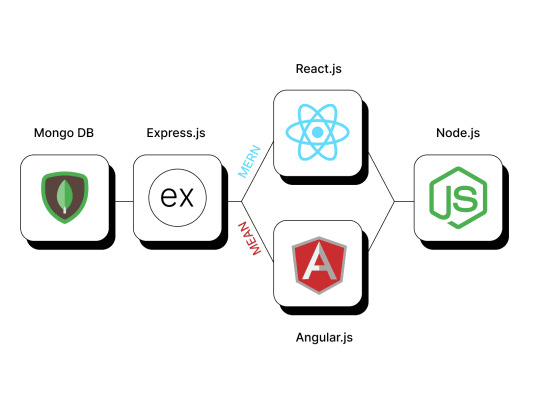
MERN Stack: MVC Architecture
(a) Model: The database’s retrieval, storing, updating, and manipulation tasks fall under this layer.
(b) View: User interactions fall under the purview of the view layer. The elements on a web page that the user can see, such as buttons, graphics, animations and colours, are referred to as the front end. This user interface makes the model layer’s data visible.
(c) Controller: This layer controls front-to-back communication between the model and the view. Its task is to receive user requests, process them with the model layer, and provide the finished product back to the view layer for the visible component.
Components of MERN
Four JavaScript-based components make up MERN Stack: MongoDB, Express.js, React.js, and Node.js, all of which are briefly described here in this post:
1. MongoDB
It is a cross-platform, open-source document-oriented database program. It is a NoSQL database with schemas based on JSON documents. MongoDB is flexible, and its document model defines objects in code, making it simple to manipulate data. It provides horizontal scaling and high availability since it is fundamentally distributed.
MongoDB’s characteristics :
· Horizontal scalability,
· High dependability,
· Cloud-native observability,
· Management tools, and geographical dispersion.
2. Express.js
The next level down is Express.js, which runs inside a Node.js server. Express.js is a “fast, un opinionated, easy web framework for Node.js,” which is just what it is. Besides HTTP requests and answers, Express.js offers robust URL routing functionality.
Businesses can link to the Express.js functions that power their applications by sending XML HTTP Requests (XHRs), GET requests, or POST requests from their React.js front end. The data in the MongoDB database is accessed and updated by those functions which use the Node.js drivers for MongoDB.
3. React.js
React.js, a declarative JavaScript framework for building dynamic client-side apps in HTML, makes up the topmost layer of the MERN stack. React allows businesses to connect simple components to data on the back-end server, connect complicated interfaces to those connections, and render those interfaces as HTML.
It contains all the bells and whistles you’d expect from a current web framework, including the best support for forms, error handling, events, lists, and more. React handles stateful, data-driven interfaces hassle-free with little code.
4. Node.js
It is a cross-platform mobile app development platform with an open-source JavaScript runtime environment for the back end. Node.js is a V8 engine running JS code outside a web app. In addition to developing original content for web apps, collecting forms, editing database data, and managing server files, Node.js can be used for various tasks.
Node.js only executes one process simultaneously rather than starting new threads for each request. It also includes a collection of I/O primitives to keep JS code from getting stuck.
Why Choose MERN Stack Development
1. Reusable Code
MERN technologies based web applications has interchangeable and reusable parts. As a result, code from one project can be reused on various platforms. This production-approved reusable component enables fast and efficient development of web apps, ensuring the shortest turnaround time.
2. Better Performance
Legacy LAMP languages (e.g. PHP) are the foundation of all open-source systems like WordPress and Shopify. While, The Node.js features, is part of the MERN stack, making it possible to manage a sequence of tasks asynchronously. This improves the capacity of programs to handle demanding events and data-driven applications. As a consequence of it, the speed of the application as a whole is multiplied, and its performance is increased.
3. Cloud Compatibility & High Scalability
There is no way that scalability can be compromised because things are constantly being uploaded to all platforms. MongoDB, a NoSQL database is highly scalable and compatible with cloud storage. Thus, the information obtained from the platforms may be conveniently managed from any worldwide location.
4. Customizable Frontend Reducing Complexity
Due to the substantial HTML content and server-side scripting, the PHP-based LAMP architecture basically uses backend coding and offers a static user experience. On the other side, the MVC architecture supported by the MERN stack allows for a limitless degree of platform frontend customization. Thus, organizations can revise their user interface to offer a distinctive experience to their users rather than managing the content via backend panels.
5. Real-Time Experience
A prominent feature of MERN stack is that it works in real-time, i.e., notifications, updates, etc., are done instantly, without the need to wait for the page to refresh.
6. Adaptable Modifications
All scripts and components are hosted on a cloud platform that’s why testing and modifying codes is comparatively more straightforward. The development and testing times are significantly shortened, and provide efficient application changes.
7. Zero Licensing
MERN has no licensing requirements. It allows libraries and public repositories to access MRN pretty quickly.
Future of MERN Stack Development
MERN stack development is conceivably the future of full-stack development due to its high speed, superior components, and simple development procedure. It gives a different and incredibly engaging user experience and assists businesses in creating highly dynamic app designs.
Since they only use a single language, proven stack technologies like MERN is ideal for projects of all sizes.
Are you looking for dedicated MERN Stack developers for next app project? Then we at AResourcepool are here to help you. Our team of experts will help you develop cross-platform, high-performance applications whether it is for eCommerce, ERP or CMS.
Content Reference:
https://markovate.com/blog/mern-stack-development/
0 notes
Text
MERN stack development
MERN Stack is a JavaScript Stack that is used for easier and faster deployment of full-stack web applications. MERN Stack comprises of 4 technologies namely: MongoDB, Express, React and Node.js. It is designed to make the development process smoother and easier.
Each of these 4 powerful technologies provides an end-to-end framework for the developers to work in and each of these technologies play a big part in the development of web applications.
Benefits
· No context switching: As for the whole application, JavaScript alone is used to build both client-side and server-side; the web application will not require context switching and provides efficient web apps.
· MVC: It provides a Model-view-Controller architecture and makes it convenient for the developers to develop the web application.
· Full-stack: With no context switching, the added advantage is that you get highly compatible and robust technologies working tangibly together and efficiently handling client and server-side development faster.
· Easy Learning Curve: The developers only need to have excellent knowledge in JS and JSON to reap its benefits while developing the web apps.
· Code Maintenance: With MERN stack development for your web apps, you get easy code maintenance and bug fixing, making it a cost-effective option. It also comes with powerful testing tools.
· Strong Community: With apps like Airbnb, Facebook, Netflix and Instagram, the technology stack has influential community support that ensures you can always find solutions out there.
· Flexibility: Apart from the already mentioned benefits, the tech stack’s components are open source and hence no licensing disputes, and with the popularity of the tech stack, you get multiple options to get the web application developed.
Components
1. MongoDB: Cross-platform Document-Oriented Database MongoDB is a NoSQL database where each record is a document comprising of key-value pairs that are similar to JSON (JavaScript Object Notation) objects. MongoDB is flexible and allows its users to create schema, databases, tables, etc. Documents that are identifiable by a primary key make up the basic unit of MongoDB. Once MongoDB is installed, users can make use of Mongo shell as well. Mongo shell provides a JavaScript interface through which the users can interact and carry out operations (eg: querying, updating records, deleting records).
2. Express: Back-End Framework: Express is a Node.js framework. Rather than writing the code using Node.js and creating loads of Node modules, Express makes it simpler and easier to write the back-end code. Express helps in designing great web applications and APIs. Express supports many middlewares which makes the code shorter and easier to write.
3. React: Front-End Library React is a JavaScript library that is used for building user interfaces. React is used for the development of single-page applications and mobile applications because of its ability to handle rapidly changing data. React allows users to code in JavaScript and create UI components.
4. Node.js: JS Runtime Environment Node.js provides a JavaScript Environment which allows the user to run their code on the server (outside the browser). Node pack manager i.e. npm allows the user to choose from thousands of free packages (node modules) to download.
Learning and training
APPWARS technologies Noida for MERN stack development, is the best training institute allover for the respective course. They provides the live sessions with their best trainers having high efficiencies and a good learning environment.
Job oriented certification will also be provided with 100% placement assistance. APPWARS technologies assures knowledge in every aspect to their learners.
APPWARS Technologies Pvt. Ltd.
(The Ministry of Corporate Affairs Registered Company and A ministry of MSME Govt. of India Approved Company)
Click on the given link to check out their website and for enrollment:
https://appwarstechnologies.com/mern-stack-development-in-noida/%0a%0a%0a%0a
0 notes
Text
Best training center for Full-stack Development
What is Full-Stack Development?
Full stack development refers to the entire depth of a computer system application, and full stack developers straddle two separate web development domains: the front end and the back end. The front end includes everything that a client, or site viewer, can see and interact with. Full-Stack Development includes knowledge about both the Front-end as well as Back-end development.
Work of a Full-Stack Developer -
Full stack developers take on a broad set of responsibilities They must be fluent in creating websites with a robust internal architecture and delivering an interactive and intuitive interface to clients. A full stack developer must be well-versed in HTML, CSS, and JavaScript and know their way around back-end technologies and database structures.
These professionals usually work with a product through its initial creation until its final launch, using industry-standard practices to ensure that technical concerns are adequately addressed at every development stack level.
Characteristics of a Full-Stack Developer -
1. Be able to work with media queries and single-page applications.
2. They should understand web frameworks like Django or Node JS.
3. They should have worked with MySQL and Mongo DB for a long time.
4. They should have some basic understanding of hybrid mobile app development.
5. Can context switch from one domain to another, and still be able to finish tasks in time.
Key Elements for being a Full Stack Developer -
· Front End
· Back End
· Database Management
· Version Control
· Operating Systems
· System Design
Front-End Developer - Front end, or client-side, development is the practice of producing an interface that end users can view. A front-end developer’s primary goal is to develop a visually pleasing and easy-to-use platform. In other words, we can say that Front-end developers are the in charge of the look and feel of the website.
Front-End Technologies
· JavaScript
· HTML
· CSS
· React
· React Native
· Angular
· Flutter
· NPM
· Vue.js
· Ionic
· Bootstrap
Back-End Developer - Back-end development refers to the work that goes on behind the scenes of a site or application — the underlying architecture of the product. The term encompasses the database, server, and other intermediary proprietary software. Developers must know how to organize the logic of a system so that the overarching program or website can run properly.
Back-End Technologies
· Ruby
· Java
· .NET
· Python
· PHP
· C#
· Golang
Database - Database is the collection of inter-related data which helps in efficient retrieval, insertion and deletion of data from database and organizes the data in the form of tables, views, schemas, reports etc.
Popular Stacks -
o MEAN Stack: MongoDB, Express, AngularJS and Node.js.
o MERN Stack: MongoDB, Express, ReactJS and Node.js
o Django Stack: Django, python and MySQL as Database.
o Rails or Ruby on Rails: Uses Ruby, PHP and MySQL.
o LAMP Stack: Linux, Apache, MySQL and PHP.
Advantages of a Full-Stack Developer -
A full-stack developer can execute agile projects with skill and proficiency, investing all their years of experience into it to attain the best product.
· All in one Solution
· Flexible
· High Responsibility Level
· Versatile
· Vast Experience
· Budget Friendly
Full-Stack Development Training
As you can see, Full-Stack Development is now one of the most trending career opportunities, if you want to learn Full-Stack Development, let me know you about the best training center, which will take you from beginner to expert in Full-Stack Development, they will also provide you with a certificate for Python Developer which will open many opportunities and career path for your future.
APPWARS TECHNOLOGIES is the best training center, you’ll get the certificate of Full-Stack Developer after completing the course.
APPWARS TECHNOLOGIES provides you with live project sessions, and every day you will learn new things, the project will be provided by the training center.
How to join the training center?
The Organization works on offline mode and online mode as well, it is located in Noida and NCR, the head office is in Noida.
Link to Join - https://appwarstechnologies.com/courses/full-stack-development-training-in-noida-2/
0 notes
Text
WCW Monday Nitro 22/07/1996
WCW opens this week with a shot of Mickey Mouse...

Because why not, I guess. As Tony welcomes us to the program we get a better image of the entrance area:

Probably should have opened with that instead of Mickey to be honest, but what do I know?
We’re treated to a shot on Tony and Larry Z with a VERY excited guy to their left.

That dude is ready for some WCW action. Going to be brutally honest and say neither of those shirts do Larry or Tony any favours.
Schaivone talks about the Olympic Games and Muhammad Ali lightning the torch at the opening ceremony. They then show video of Bishcoff giving a cheque to Ali at Halloween Havoc 1994, for a charity of some kind I assume.
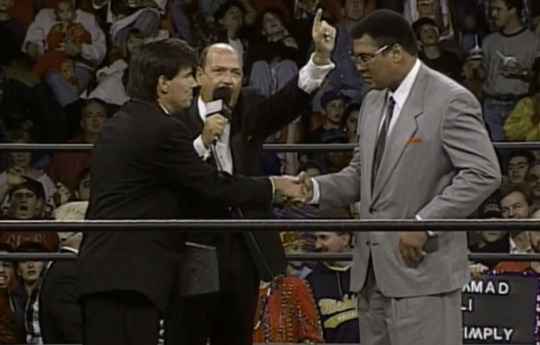
Ali in his prime would have been 100% nWo, for the record.
As Tony continues to go on about this, there are two ladies in the crowd looking very confused:

Like the cameraman is actually an alien or something.
They then switch to Shaq with Hogan, for some reason...
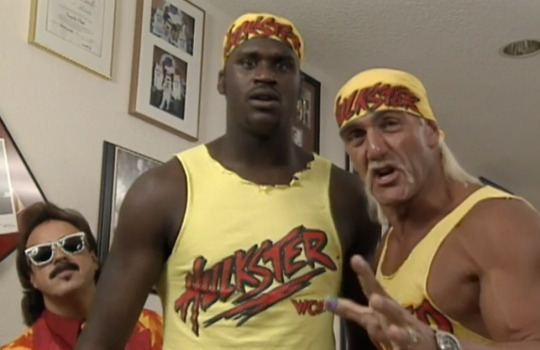
Again, from years ago. Not sure what relevance this has to the current program. Shaq looks like he’s just realised Jimmy Hart is squeezing his ass, though.
Tony says they will have an answer tonight from the Giant as to whether he’ll accept Hogan’s challenge for the Hog Wild PPV on August 10th. Larry says the Dungeon of Doom will force the Giant to defend his title against Hogan. Because you obviously can’t say no to Sullivan and those stupid, painted on eyebrows.
They show the Outsiders’ bedsheet stunt from last week (it’s amazing how much of the Outsiders they show on this program, considering they apparently don’t want them there).
Our first match begins 3 minutes and 30 seconds into the program. The Blue Bloods music is playing and I’m hoping it’s No Fucks Given Steven Regal, but unfortunately it’s just Squire Dave Taylor along with Jeeves.

Tony says this is “the hottest ticket in Orlando”, which is funny as I’m not sure the people there actually paid for tickets. I could be wrong but I think they were just allowed in as general park guests.
Next out is the eternally pissed off Scott Norton. The commentators tell us that Ice Train Vs Scott Norton has been signed for Hog Wild, on the basis of last week’s argument I guess.

“Squire” Dave Taylor Vs Scott Norton
The Squire is the bad guy here, pretty much just because he isn’t American. The crowd chant “USA” at the start of the match to confirm Taylor is not welcome. This match consists largely of Taylor hitting about twenty european uppercuts whilst running into Norton a few times and falling over. Then this happens.

Taylor is thrown over the top rope onto the floor. No big deal, right? WRONG. The ref calls for the fucking bell and disqualifies Norton. There is no crowd reaction whatsoever. This was a total waste of time for all involved.
“Squire” Dave Taylor defeats Scott Norton via Disqualification.
The pair of them brawl on the outside for a while as Tony and Larry finally catch up to the fact Norton has been disqualified, as if the bell ringing constantly wasn’t a big enough indicator.

Norton carries Taylor on his back past the announce team, including the silent blonde woman, and they all duck to avoid being hit by Taylor’s boot or Norton’s girth. Taylor then just kind of falls off Norton’s back and rolls onto the floor. The referee declares Taylor the winner, and he’s very pleased with this.

Wonderful. Jeez, have only 7 minutes of this show gone by so far?
IRS, aka VK Wallstreet, is cutting a pre-taped promo for his upcoming match against Konnan.

You’ve gotta love the dollar symbol on his jacket. Just to let you know he’s all about money.
Anyway, he tells Konnan that “VK Wallstreet knows international markets and knows international superstars”, he calls K-Dogg the “kingpin of Mexico” but that there’s going to be a “hostile takeover” and Konnan had better be ready. He says this with all the intensity of an infomercial about the benefits of herbal soap.
We come back and Mean Gene is with Arn Anderson, Mongo, Benoit, Debra, Woman and Liz.

They’ve set up that fucking VIP area again. WHY CANDLESTICKS? IT’S STILL LIGHT AND THEY AREN’T EVEN LIT. WHY A MASSIVE PINEAPPLE AND A BIG BOWL OF FRUIT?
Well, at lest they’re using the area I suppose. Gene asks where Flair is. Anderson says it might be a question in Gene’s mind but it isn’t in any of theirs. He says Flair likes expensive cars and beautiful women, but that he likes one thing more than anything else. Gene says “he likes to showboat” and Arn continues “he likes to make an entrance”. I suppose that’s broadly the same thing. Arn says Flair will be here “right on cue” then takes a bite out of an apple.

Doesn’t look very tasty.
Gene switches to Mongo and says he’s got his work cut out for him tonight. Mongo yells “OH! Thank you Mean Gene” and says it’s been his pleasure to “take care of a few pretty boys in the WCW” and now he gets a shot at the “real pretty boys” in Macho, Luger and Sting. One of those three fits that description a lot less than the others. Mongo is certainly happy though.

Okerlund suggests to Benoit that Sting, Luger and Macho Man might take out their frustrations regarding the nWo on the Horsemen tonight. Chris Benoit says the three of them will experience the crippler first hand, “unrelentless, vicious, merciless. Silent but violent”

Not sure what the fuck Arn is doing with his face here - did he bite into a sour part of the apple? - but for the record “unrelentless” isn’t a word. You could tell Benoit knew he’d fucked up as he paused briefly after saying it... but it was too late.
Gene gets a bit too comfortable and asks Mongo for a banana. Mongo pretends to throw it at Gene, who reacts like Mongo is about to chuck a rock at him.

Arn is also holding up a banana.
Our second match is set to begin.

Why this guy is wrestling rather than checking the stock market or whatever else is beyond me. There’s an “IRS” chant as he comes out.
Next out is Konnan looking... colourful.

I swear these guys both came out to the exact same generic, plodding instrumental rock song. Most people are cheering Konnan, but...

Check out the guy on the right. He is booing and giving the thumbs down to Konnan as aggressively as he possibly can. He looks fucking enraged. There is a sharp contrast in style between him and the three beside him.
Konnan Vs VK Wallstreet
Larry says that Konnan wants the US title back because “he might not get back into the country without it”. It’s not a green card, Larry.
There’s a fat kid in the front row entertaining himself by doing poses.

In fairness the match is nothing to get excited about.
VK “IRS” Wallstreet dominates the match and spends the bulk of it working on Konnan’s leg. At one point Larry starts talking about putting women in their place again, but Tony shuts it down straight away.
Fat kid and his mother or father (can’t really tell) are waving at the camera a lot.

Well at least they’re having fun I guess. Dat Marvin the Martian t-shirt.
There’s a lot of rest holds in this one. Fairly sure I heard some “boring” chants.
Match ends when Wallstreet hits Konnan with a samoan drop (which Tony calls the “Wall Street Crash” - geddit?) but then Konnan rolls him up for the pin and this one is over.

Konnan defeats VK Wallstreet via Pin.
Okerlund is back with Sting, Luger and the Macho Man.

Sting is half-hopping on one leg like he forgot to take a piss before he came out.
Gene notes to Lex Luger that Flair isn’t here yet. Luger says Flair is “probably somewhere”. Yes, you’d hope so. Luger says that last week he got “stomped into a mudhole” (but wasn’t walked dry), “but where were (sic) everybody else? The Stinger and the Macho were in Japan”. He pauses for a moment, giving the camera a look...
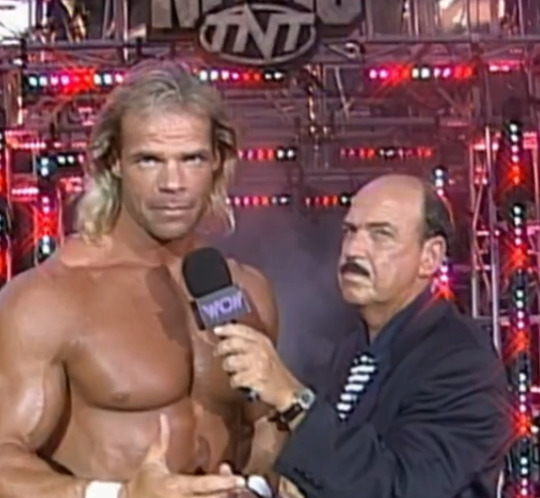
Before repeating multiple times that they are here to make “a statement” - seriously, he says this about five times in the space of a minute.
Sting says that there’s only one guy around here who rides around here in a “big fat limo” and he can “stick it” ... Gene’s face here is hilarious.

Um...
Anyway, Sting says he doesn’t care where Flair is, he just wants to chomp on a Horseman tonight. Alrighty.
Gene says to Savage that he knows the Horsemen very well. Macho yells that he just wants to fight everybody and get it over with in one night. Oh, Macho, if only you knew.
Another Glacier promo airs. It’s funny because the original promos said “Glacier - coming July 1996″, then it changed to “Glacier - coming soon” and now it just says “Glacier”. From what I remember he debuted in September, so... yeah. Not sure what the delay was other than the realisation Glacier was a really shit concept... but I suppose after all the money spent on vignettes they felt they had to put him out there. We’ll get to that.
Tony says we’re about to see a “brand new 8-man tag”, as if that hasn’t been done before, then there’s a vignette on the participants. It starts with the four of them just... standing on some bridge, whilst generic rock music plays.

I think that’s “jobber” Jim Powers on the right, aloof from the group. He’s way too cool to be standing around with those dorks. Then Powers is walking towards us on the sand taking his shirt off, so we’re now essentially watching Baywatch...

He throws down the t-shirt aggressively, like he’s angry, but we don’t know what he’s angry about. Did he open the fridge and find that his last can of tuna had been eaten? Did he find his girlfriend cheating on him with another dude? Did another wrestler steal his “happy juice”? We’ll never know. I’ve just realised Powers is what would happen if you fused early 90′s Scott Steiner with Rhyno.
Anyhow, we basically see the exact same shots of Joe Gomez, Alex Wright and the Renegade. Close ups of their faces followed by them walking towards us on the sand taking their shirts off whilst the same generic rock music plays. WCW does realise this show is watched largely by men, right? I mean, I’m sure some guys enjoyed that, but I can’t help but think the general demographic isn’t going to be enthused by these guys posing like they’re in a crossover between Baywatch and a boy band video.

The original JOB squad.
We thankfully cut back to the arena (where that same fucking song still is playing) and Tony says this will be a “wild and woolly” eight man tag. I’m pretty sure only half of that description makes sense.
Schiavone tells us a “new member” of the Dungeon of Doom is about to be revealed in this eight man tag. This should be good. Sullivan did say he wanted to bring “all athletes” into the Dungeon so maybe it’ll be Linford Christie.

Three members of the DoD come out (along with Jimmy Hart), then suddenly a ginger guy wearing stereotypical old Irish clothes comes running out. As he sprints around the ring baring his teeth like a rabid dog, Tony says that he’s called “the leprechaun”.

I mean, it’s not worse than “the Shark”, but for goodness sake. It’s basically a normal-sized version of Hornswoggle acting like he has the infection from 28 Days Later. This guy is better known as Sgt. Buddy Lee Parker and was one of the main trainers at the WCW Power Plant. This was clearly a demonstration of how some gimmicks will leave you dead on arrival.
The Original JOB Squad Vs The Dungeon of Doom
We are literally about ten seconds into the match before Tony says “there’s a disturbance in the back” and the cameraman literally turns away from the ring and starts running towards the backstage area. Because fuck the match. Some asshole is constantly blowing a whistle, also, which is annoying as hell.
We see a bit more of the match before cutting again to the back.
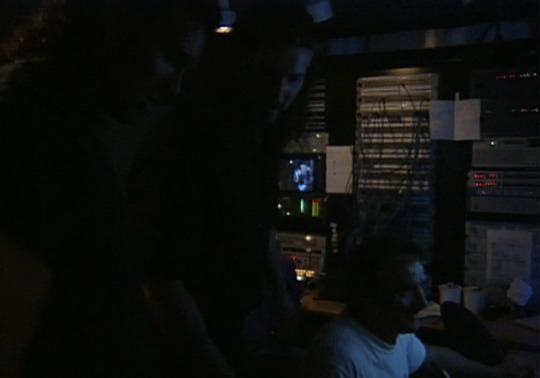
Hard to see in the dark light but basically the Outsiders have entered the production truck, which evidently has absolutely no security in place whatsoever. It’s amazing how Hall and Nash are pretty much able to do as they please with no security there to try and intervene.
The Outsiders make the screen fade to black in and out. Tony and Larry are asking how and why Hall and Nash are able to waltz in and just start fucking around with a pretty huge TV show’s live production. Good questions.

Hall and Nash put in headsets and start directing camera shots. Obviously as the TV cameras are actually focused on them they are literally affecting nothing, but... whatever. They look like they’re having a lot of fun, and in fairness this is probably more entertaining than the match going on in the ring.
We do start seeing random crowd pans.

This kid’s tank top appears to be a few sizes too big. It’s literally falling off him. At first I thought it said “milf” along the top but I don’t think it does. I’m fairly sure that wasn’t a term in 1996. Those were more innocent days.
WCW yellowshirt security finally arrives and calmly ushers the Outsiders out of the production truck, telling them “we’re trying to do a show”. No shit.
We go back to the match, which Tony calls “high impact”. We wouldn’t know because we’ve literally seen nothing of it. Schiavone is getting more and more upset by the Outsiders being at “master control”, as he keeps calling it, and says “it’s a crime”. Well... yes, it probably is.
As Jim “Jobber” Powers stands around outside the ring...

Holla! Teddy Long comes out and informs him next week on Nitro HE’S GOING ONE ON ONE WITH... no, no he doesn’t. We can’t really hear what he’s saying because Zybszko is yelling, asking why Long is out there.
Powers is fired up by whatever Teddy says and starts cleaning house on the Dungeon. The match breaks down, then out comes the Giant.

He chokeslams the Renegade, Gomez, Powers and “Junior Hitler” Alex Wright. The jobbers are disposed of, the match is obviously thrown out.
The Original JOB Squad defeat The Dungeon of Doom via Disqualification.
Giant accepts a well deserved round of applause for ending that match.

Okerlund rushes to the ring to get involved. He tells Jimmy Hart “you scare me... especially when you’re behind me like that.”

OK. By the way, check out the back of Jimmy’s jacket.

Now if the Taskmaster actually made the effort to put that facepaint on then he’d actually look slightly less stupid. Instead he just chucks on a couple of silly eyebrows and says “that’ll do”. Put a little pride in your work, Sullivan.
Gene asks Giant whether or not he’ll accept Hogan’s challenge for Hog Wild. Giant says that when he came into WCW it was his mission to win the World Heavyweight Championship, and he did that. He said once he won the title he “swore an oath” to defend the belt wherever he needed to defend it. That’s kind of how it works when you’re a champion anyway, but sure.
Giant says that whilst Hogan has been off in Hollywood making movies and trying to win an Oscar (lol), he’s been wreaking havoc as the “cancer” of WCW. Giant says that once the nWo turned up WCW came running to him, asking what they can do about the nWo. Giant says he’ll chokeslam them all in the middle of the ring. There you go. Easy solution. What was everybody so worried about?
Gene says to Jimmy Hart that “we saw you at the top of the program with Shaquille and Hulk” ... does Okerlund realise that was in the distant past? Hart ignores Gene and simply says “Hogan, the Giant will be ready for Hog Wild”. Good to know.

The Giant has at least one supporter behind him.
There’s an advert for WCW Saturday Night, before we cut straight back to a match. The entrances were not televised so we’ll get straight into it.
Diamond Dallas Page Vs Prince Iaukea
I had to google the Prince’s last name. Easy to say, harder to spell. It’s just a case of getting all the vowels in the right places.
Prince is still wrestling barefoot for some reason. You would have thought somebody would have advised him to put some boots on by now. They aren’t just a fashion accessory, kid.
This match lasts a couple of minutes before Page bounces off the ropes and hits the diamond cutter.

Diamond Dallas Page defeats Prince Iaukea by Pinfall.
Chavo appears in an “up next” promo where he basically tells Dean Malenko to get ready for a fight.

Those eyes mean business.
We get a promo video on the Benoit/Sullivan feud. It focuses on Sullivan’s worrying obsession with taking his opponents to the men’s restroom. No comment.
Chavo Jr is out... no name graphic, though.

For some reason these people are dancing along to Chavo’s generic rock theme...

Except the little girl in the bottom left, who looks bored beyond belief. In her defence, it’s not been a stellar night as far as matches are concerned.

Deano is out next... no name graphic for him, either. I wonder if the Outsiders legit fucked up something in the production truck?
Chavo Guerrero Jr Vs Dean Malenko
The match begins and there are two oddities. Firstly I’m fairly sure the bell doesn’t ring to start the match, it just starts. Also the camera is panning across the crowd/nitro logo and totally misses the match starting. Good job. Maybe the Outsiders are actually still in the production truck controlling this thing.
A fast paced start to this one. Stinko eventually slows it down and starts hitting a bunch of suplexes and shit. Hour two is about to start and Tony has to remind us about the countdown because the little dynamite count down stick that’s usually in the bottom right corner is not there. I guess they really can’t get any on screen graphics up!

Fireworks go off and Eric Bischoff comes screaming through the audio as if he’s yelling to us from the end of a telephone line. They eventually get this under control, and Bischoff is way more enthusiastic than Tony was towards the end of that first hour.
Bischoff says that Heenan looks nervous, and although Heenan starts to talk you can’t actually hear him. He’s wayyyy in the background. Looks like production glitches aren’t just limited to the onscreen graphics. Some kind of gong sound affect briefly cuts off Bischoff before Heenan comes roaring into commentary on an unnecessarily high volume.
Malenko continues to work over Chavo as a lone person chants “boooring”. It really isn’t. The match is decent enough.
I’m telling you, that fat kid and the people who I assume are his family must be some of the most annoying people on the planet judging by how they’re acting like the front row. They’ve spent most of the show waving at the camera, making stupid poses and pretending to ‘fight’ each other. See example below:

To be fair to the guy on the far left, he’s not really getting so involved with it, but mustache, pink shirt and the chubby funster are just acting like idiots nonstop. Check out the expression of the kid sitting next to fatso:

Yeah. I feel for you.

Malenko has Chavo in this hold for a while, as fireworks randomly start going off.

Towards the end of the match Jimmy Hart randomly appears to start shotuing encouragement to Malenko. It wasn’t really needed as Malenko has been in pretty much total control for 95% of the match anyway.
Malenko gets distracted by the mouth of the south, which allows Chavo to sneak up from behind and nearly get the roll-up victory.

But he only gets a two count. Chavo then attempts an inside cradle for another two count.
Match ends when Chavo jumps off the top turnbuckle, but is caught in mid-air by Malenko, slammed to the mat and then wrapped into the Texas Cloverleaf. Game over.
Dean Malenko defeats Chavo Guerrero Jr via Submission.
Bischoff continues to hype up Hog Wild with the tagline of one million bikers and you, or whatever. They all get in free so no gate receipts for WCW. Great idea.

Meng is yelling largely unintelligible stuff. Jimmy Hart tells Ice Train that after he faces Meng he’ll be “cold as ice”. So, dead then?

We’re back with Bobby and Eric, who says the Outsiders were “slippery enough” to get into the production truck. I mean... come on. Look at them. Two guys over six and a half feet. They aren’t ghosting in there, are they? It’s just lack of security.
Eric then starts talking about the Giant/Hogan match, he says “talk is cheap, Hogan, and so are you”. There’s a lot of accusations you can level at the Hulkster, brother, but being cheap certainly isn’t one of them. Dude was one on hell of a wedge.
We’re onto the next match, out comes Ice Train...

Bischoff reckons Ice Train could be one of “the brightest stars in the years to come”. Not quite, Eric, not quite. They’ve at least got the on screen graphics back up, so that’s something. I do love how happy Ice Train looks when he comes out though.

You get the feeling he’s just a super positive guy.
The crowd are apparently loving the Train...

Except the little girl in the right. I think she’s actually crying. “No more jobbers, please”.
His opponent is Meng.
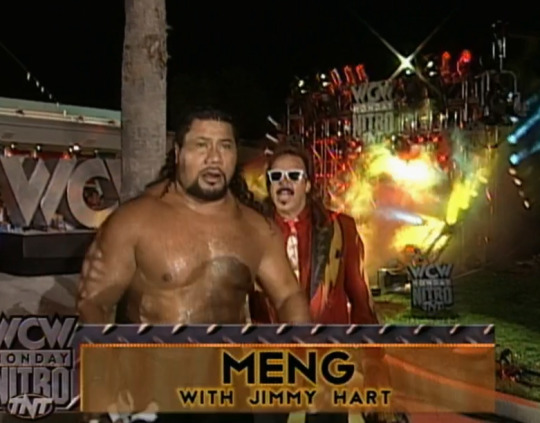
Get the feeling this one could be quite a stiff match. Ice Train is an absolute tank and Meng is... well, Meng. Speaking of Meng, Eric Bischoff says that “one hundred years ago, these people were cannibals”. I’m not sure that’s true. Apparently Tonga was known as “the friendly islands” when first discovered by European settlers and that was in 1773. It wasn’t the amazon jungle.
Ice Train Vs Meng
Ice Train starts off this match with some impressive agility, managing a leapfrog over Meng and hitting him with a flying cross body.

That is one heavy collision.

Teddy is out here again, watching the match. This guy is all over the place recently.
Meng and Train exchange some brutal chops outside the ring, before they get back inside and Train takes control. Meng swings momentum back his way and hits a huge leg drop. Meng pretty much continues to dominate. The match is very slow, as you might imagine.
The match ends when Meng and Train are fighting on the outside, and suddenly Scott Norton appears and attacks Meng.

Norton rams Meng’s head into the ringpost and that’s a DQ.
Meng defeats Ice Train via Disqualification.
Norton yells into the camera that he’s got Ice Train’s back, and Train won’t have to worry about anything until Hog Wild.

Could have just told him face-to-face, he’s literally a few feet away, but OK. Also not sure how this is watching Train’s back, he just got the guy disqualified. It’s not like Train was being double-teamed by the Dungeon.
A promo airs of Hogan’s heel turn at the Bash of the Beach and subsequent events, with an attempt at dramatic storytelling by some guy. He asks “who’s next to join the New World Order?”
Up next...

Eddie says to never underestimate a person, even after you’ve beaten them. Um... well, by that point it doesn’t really matter, does it? I guess he means in the subsequent rematch.
We then get another Glacier promo. The same one as earlier in the night. They could have at least made two or three to help add variety.
Now it’s a promo for Hog Wild. Jeez... are we ever going back to the arena?
Finally, out comes Psychosis.

He has cool music. I can remember thinking Psychosis in general was a decent wrestler with an interesting look. A shame he never really did anything useful in WCW.
Eddie it out and he gets a random burst of pyro from the top of the set.


Eddie Guerrero Vs Psychosis
Early “Eddie” chant from the crowd.
Fast chain wrestling to open the bout. It continues in typical lucha fashion. Eddie clotheslines Psychosis over the top rope...

That’ll be a DQ, right? It was for Scott Norton earlier. No? No. Apparently not this time. Always cool when the rules are just applied whenever it suits the storyline. Helps build consistency.
Well anyway, Eddie flies off the top onto Psychosis...

Bischoff says this is what makes WCW the most exciting place to be. What, rules applied differently depending on the match? Sure, very exciting.
Eddie rolls Psychosis back into the ring, hits a belly-to-back suplex and gets a two. Psychosis manages to hit some offence, then gets up onto the top turnbuckle and hits a flying spin kick.

Eric says that it is “magic”. Psychosis hits a suicide dive on Eddie, then a guillotine leg drop from the top rope.

The landing looks brutal on the back and buttocks though. Bischoff mentions that Psychosis is from “Triple A” and also name drops NJPW, which is interesting, as usually they just say “Mexico” or “Japan” rather than naming specific promotions. From what I remember WCW did have a working relationship with AAA and NJPW so it makes sense for them to mention the companies. They just don’t normally do so.
Match ends when Eddie hits a frankensteiner off the top rope on Psychosis, then gets up there again and flies with the frogsplash...

Doesn’t get much air on it so the landing looks kinda rough for poor old Psychosis. Anyhow, your winner is Eddie Guerrero.
Eddie Guerrero defeats Psychosis via Pinfall.
Eddie has possibly been the most over wrestler on the show so far. Not a high bar, granted, but still...
Ric Flair’s music hits and some random guy is peering out of the “C” of the WCW sign.

Hello.

We’ve got two horsemen and three horsewomen (?) but no Slick Ric.
We come back from a break to this...

Arn Anderson peering through blacked out limo windows, I assume looking for Flair. I find it odd that Flair hasn’t so much as contacted his best friend to let him know where he is, and Anderson instead has to resort to trying to see through dimmed limo windows. I know this is the era before cell phones were a big thing but surely somebody could have borrowed Booker T’s huge ass phone to make a call.
Arn eventually gives up and walks to the ring. Looks like he’ll be taking Flair’s place.
Out come Sting, Luger and Savage.

The name graphics have disappeared again, by the way. Never mind.
Bischoff is insinuating that Flair might have joined the nWo. Heenan refuses to believe it.
Mongo, Benoit & Arn Anderson Vs Sting, Luger & Savage
Sting and the Endomorph start things. Anderson pushes Sting, who shoves Arn back. Arn goes flying like Sting smacked him with a sledgehammer. Sting gives Arn a back body drop, then Benoit enters the ring.

Dealt with.
Macho is wearing an extremely colourful outfit.

Like somebody took a paintbrush and just went crazy. It works for him though.
Mongo hits a fairly basic neckbreaker and the commentators act like he just performed a flying headscissors. “What a move from Mongo!” yells Heenan. Yeah. He then calls Mongo “phenomenal”. I think we have very different definitions of that word, Brain.
Mongo hits one if the shittiest looking drop kicks I’ve ever seen.

Heenan goes wild, screaming “look at that drop kick out of McMichaels!” ... maybe he’s actually being sarcastic.
We get a shot of the limo...

Did they not do this same schtick a couple of weeks back? Just ban limos from the area. Problem solved.
Benoit beats on Sting in the ring. I don’t think Luger or Savage have literally done anything yet. Sting’s done all the work.
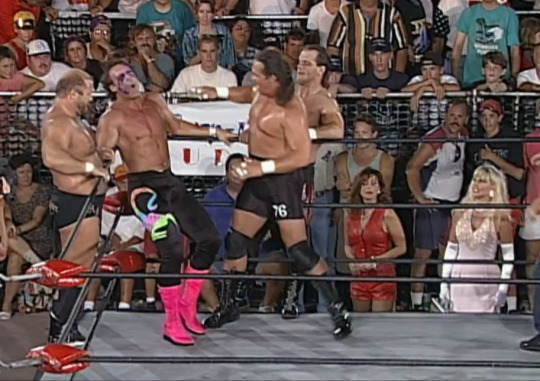
The Horsemen are still beating on Sting. There’s only a few minutes of the program left so we aren’t going to see much from Macho or Luger tonight. Easy money.
After what seems like an eternity Sting FINALLY tags in Luger, who comes in and starts decking all three of the horsemen.

Luger’s body is extremely shiny. It’s really noticeable.
The match starts to break down with all six men fighting in the ring.

You know something is about to go down. The camera cuts to the women - Debra is about to throw the metal briefcase in to Mongo, but for some reason Woman grabs it before she can and they have a brief tug-of-war. The Macho Man then appears and grabs the briefcase off them.

Bad intentions.
Savage comes in with Mongo’s metal briefcase and whacks Benoit in the back with it. Luger makes the cover...

And your team of babyfaces win using decidedly heel tactics. OK. I guess if you can’t beat them, join them? The crowd are delighted either way.
We come back after the break and Mean Gene is in the ring with Sting, Luger and Savage. Something gets thrown in the ring, Gene says “please lady, don’t throw your underwear in here. It’s in bad taste” ... at a theme park, I would say so. Jeez. Macho says “that’s OK”. He doesn’t mind.
Sting is first up. Gene asks him about the match he and Luger have against the Outsiders at Hog Wild.

For some reason Sting is holding on to the briefcase. Not a bad idea if the nWo are around in fairness. He seems to be pondering Gene’s question carefully.
Sting says that last week “the Total Package was feeling kind of beat down, you know what I’m saying?” ... well, yes, he was quite literally beaten down. A bit harsh for Sting to be making light of that but whatever. Sting says he and Luger aren’t feeling down, they’re just feeling mean. “I mean real mean”. Sting says he knows when the Outsiders’ birthdays are, and he doesn’t believe in horoscopes, and he was thumbing through the newspaper and the PPV is going to be really bad for them. The date matches Leos and that makes the Outsiders Leos... erm...

Indeed.
Luger says that the Outsiders have been pushing all the wrong buttons since they first came onto the scene. He says they’ve done a good job of pushing the three of them over the edge. Luger screams that he’s “losing it”, he says he cares about WCW and the Outsiders have had nothing but “disgust, disdain, and sarcasm” for it. Sarcasm doesn’t seem as bad as the first two but I get where he’s going. He says that at the PPV they’ll learn what he, Sting, Macho, WCW and the fans mean. I rag on Luger sometimes but I thought he had good, intense delivery here. He can cut a good promo when he isn’t stumbling over words.
Macho Man is next.

He says he’s talking directly to Hogan (with Luger giving the evil eye in the background). Macho says he’s going to beat Hogan up in the aisle before he gets to the ring to even face the Giant at Hog Wild. You might have wanted to keep that plan to yourself, Macho. Savage says the army, the navy and the militia aren’t going to be able to stop him kicking Hogan’s head in. Not sure the navy would have anything to do with it unless the fight spills onto a boat somewhere, and what’s the difference between the army and the militia?
Macho finishes the promo by saying “we’ve got a date, don’t be late, suckerrr!” as Luger gurns into the camera and Sting makes a weird face.

Our heroes, ladies and gentlemen.
The show ends there. So no Outsiders or Hulk Hogan. We never find out who was in the limo either. Could have just been somebody randomly parked there, terrified as the Endomorph creepily tries to peer in.

“If I stay really still and quiet, he’ll go away eventually.”
2 notes
·
View notes
Photo

Local Authentication Using Passport in Node.js
A common requirement when building a web app is to implement a login system, so that users can authenticate themselves before gaining access to protected views or resources. Luckily for those building Node apps, there’s a middleware called Passport that can be dropped into any Express-based web application to provide authentication mechanisms in only a few commands.
In this tutorial, I’ll demonstrate how to use Passport to implement local authentication (that is, logging in with a username and password) with a MongoDB back end. If you’re looking to implement authentication via the likes of Facebook or GitHub, please refer to this tutorial.
As ever, all of the code for this article is available for download on GitHub.
Prerequisites
To follow along with this tutorial, you’ll need to have Node and MongoDB installed on your machine.
You can install Node by heading to the official Node download page and grabbing the correct binaries for your system. Alternatively, you can use a version manager — a program that allows you to install multiple versions of Node and switch between them at will. If you fancy going this route, please consult our quick tip, “Install Multiple Versions of Node.js Using nvm”.
MongoDB comes in various editions. The one we’re interested in is the MongoDB Community Edition.
The project’s home page has excellent documentation and I won’t try to replicate that here. Rather, I’ll offer you links to instructions for each of the main operating systems:
Install MongoDB Community Edition on Windows
Install MongoDB Community Edition on macOS
Install MongoDB Community Edition on Ubuntu
If you use a non-Ubuntu–based version of Linux, you can check out this page for installation instructions for other distros. MongoDB is also normally available through the official Linux software channels, but sometimes this will pull in an outdated version.
Note: You don’t need to enter your name and address to download MongoDB. If prompted, you can normally dismiss the dialog.
If you’d like a quick refresher on using MongoDB, check out our beginner’s guide, “An Introduction to MongoDB”.
Authentication Strategies: Session vs JWT
Before we begin, let’s talk briefly about authentication choices.
Many of the tutorials online today will opt for token-based authentication using JSON Web Tokens (JWTs). This approach is probably the simplest and most popular one nowadays. It relegates part of the authentication responsibility to the client and makes them sign a token that’s sent with every request, to keep the user authenticated.
Session-based authentication has been around longer. This method relegates the weight of the authentication to the server. It uses cookies and sees the Node application and database work together to keep track of a user’s authentication state.
In this tutorial, we’ll be using session-based authentication, which is at the heart of the passport-local strategy.
Both methods have their advantages and drawbacks. If you’d like to read more into the difference between the two, this Stack Overflow thread might be a good place to start.
Creating the Project
Once all of the prerequisite software is set up, we can get started.
We’ll begin by creating the folder for our app and then accessing that folder on the terminal:
mkdir AuthApp cd AuthApp
To create the node app, we’ll use the following command:
npm init
You’ll be prompted to provide some information for Node’s package.json. Just keep hitting Return to accept the default configuration (or use the -y flag).
Setting up Express
Now we need to install Express. Go to the terminal and enter this command:
npm install express
We’ll also need to install the body-parser middleware which is used to parse the request body that Passport uses to authenticate the user. And we’ll need to install the express-session middleware.
Let’s do that. Run the following command:
npm install body-parser express-session
When that’s done, create an index.js file in the root folder of your app and add the following content to it:
/* EXPRESS SETUP */ const express = require('express'); const app = express(); app.use(express.static(__dirname)); const bodyParser = require('body-parser'); const expressSession = require('express-session')({ secret: 'secret', resave: false, saveUninitialized: false }); app.use(bodyParser.json()); app.use(bodyParser.urlencoded({ extended: true })); app.use(expressSession); const port = process.env.PORT || 3000; app.listen(port, () => console.log('App listening on port ' + port));
First, we require Express and create our Express app by calling express(). Then we define the directory from which to serve our static files.
The next line sees us require the body-parser middleware, which will help us parse the body of our requests. We’re also adding the express-session middleware to help us save the session cookie.
As you can, see we’re configuring express-session with a secret to sign the session ID cookie (you should choose a unique value here), and two other fields, resave and saveUninitialized. The resave field forces the session to be saved back to the session store, and the saveUninitialized field forces a session that is “uninitialized” to be saved to the store. To learn more about them, check out their documentation, but for now it’s enough to know that for our case we want to keep them false.
Then, we use process.env.PORT to set the port to the environment port variable if it exists. Otherwise, we’ll default to 3000, which is the port we’ll be using locally. This gives you enough flexibility to switch from development, directly to a production environment where the port might be set by a service provider like, for instance, Heroku. Right below that, we called app.listen() with the port variable we set up and a simple log to let us know that it’s all working fine and on which port is the app listening.
That’s all for the Express setup. Now it’s on to setting up Passport.
Setting up Passport
First, we install Passport with the following command:
npm install passport
Then we need to add the following lines to the bottom of the index.js file:
/* PASSPORT SETUP */ const passport = require('passport'); app.use(passport.initialize()); app.use(passport.session());
Here, we require passport and initialize it along with its session authentication middleware, directly inside our Express app.
Creating a MongoDB Data Store
Since we’re assuming you’ve already installed Mongo, you should be able to start the Mongo shell using the following command:
mongo
Within the shell, issue the following command:
use MyDatabase;
This simply creates a datastore named MyDatabase.
Leave the terminal there; we’ll come back to it later.
Connecting Mongo to Node with Mongoose
Now that we have a database with records in it, we need a way to communicate with it from our application. We’ll be using Mongoose to achieve this. Why don’t we just use plain Mongo? Well, as the Mongoose devs like to say on their website:
writing MongoDB validation, casting and business logic boilerplate is a drag.
Mongoose will simply make our lives easier and our code more elegant.
Let’s go ahead and install it with the following command:
npm install mongoose
We’ll also be using passport-local-mongoose, which will simplify the integration between Mongoose and Passport for local authentication. It will add a hash and salt field to our Schema in order to store the hashed password and the salt value. This is great, as passwords should never be stored as plain text in a database.
Let’s install the package:
npm install passport-local-mongoose
Now we have to configure Mongoose. Hopefully you know the drill by now: add the following code to the bottom of your index.js file:
/* MONGOOSE SETUP */ const mongoose = require('mongoose'); const passportLocalMongoose = require('passport-local-mongoose'); mongoose.connect('mongodb://localhost/MyDatabase', { useNewUrlParser: true, useUnifiedTopology: true }); const Schema = mongoose.Schema; const UserDetail = new Schema({ username: String, password: String }); UserDetail.plugin(passportLocalMongoose); const UserDetails = mongoose.model('userInfo', UserDetail, 'userInfo');
Here we require the previously installed packages. Then we connect to our database using mongoose.connect and give it the path to our database. Next, we’re making use of a Schema to define our data structure. In this case, we’re creating a UserDetail schema with username and password fields.
Finally, we add passportLocalMongoose as a plugin to our Schema. This will work part of the magic we talked about earlier. Then, we create a model from that schema. The first parameter is the name of the collection in the database. The second one is the reference to our Schema, and the third one is the name we’re assigning to the collection inside Mongoose.
That’s all for the Mongoose setup. We can now move on to implementing our Passport strategy.
Implementing Local Authentication
And finally, this is what we came here to do! Let’s set up the local authentication. As you’ll see below, we’ll just write the code that will set it up for us:
/* PASSPORT LOCAL AUTHENTICATION */ passport.use(UserDetails.createStrategy()); passport.serializeUser(UserDetails.serializeUser()); passport.deserializeUser(UserDetails.deserializeUser());
There’s quite some magic going on here. First, we make passport use the local strategy by calling createStrategy() on our UserDetails model — courtesy of passport-local-mongoose — which takes care of everything so that we don’t have to set up the strategy. Pretty handy.
Then we’re using serializeUser and deserializeUser callbacks. The first one will be invoked on authentication, and its job is to serialize the user instance with the information we pass on to it and store it in the session via a cookie. The second one will be invoked every subsequent request to deserialize the instance, providing it the unique cookie identifier as a “credential”. You can read more about that in the Passport documentation.
Routes
Now let’s add some routes to tie everything together. First, we’ll add a final package. Go to the terminal and run the following command:
npm install connect-ensure-login
The connect-ensure-login package is middleware that ensures a user is logged in. If a request is received that is unauthenticated, the request will be redirected to a login page. We’ll use this to guard our routes.
Now, add the following to the bottom of index.js:
/* ROUTES */ const connectEnsureLogin = require('connect-ensure-login'); app.post('/login', (req, res, next) => { passport.authenticate('local', (err, user, info) => { if (err) { return next(err); } if (!user) { return res.redirect('/login?info=' + info); } req.logIn(user, function(err) { if (err) { return next(err); } return res.redirect('/'); }); })(req, res, next); }); app.get('/login', (req, res) => res.sendFile('html/login.html', { root: __dirname }) ); app.get('/', connectEnsureLogin.ensureLoggedIn(), (req, res) => res.sendFile('html/index.html', {root: __dirname}) ); app.get('/private', connectEnsureLogin.ensureLoggedIn(), (req, res) => res.sendFile('html/private.html', {root: __dirname}) ); app.get('/user', connectEnsureLogin.ensureLoggedIn(), (req, res) => res.send({user: req.user}) );
At the top, we’re requiring connect-ensure-login. We’ll come back to this later.
Next, we set up a route to handle a POST request to the /login path. Inside the handler, we use the passport.authenticate method, which attempts to authenticate with the strategy it receives as its first parameter — in this case local. If authentication fails, it will redirect us to /login, but it will add a query parameter — info — that will contain an error message. Otherwise, if authentication is successful, it will redirect us to the '/' route.
Then we set up the /login route, which will send the login page. For this, we’re using res.sendFile() and passing in the file path and our root directory, which is the one we’re working on — hence the __dirname.
The /login route will be accessible to anyone, but our next ones won’t. In the / and /private routes we’ll send their respective HTML pages, and you’ll notice something different here. Before the callback, we’re adding the connectEnsureLogin.ensureLoggedIn() call. This is our route guard. Its job is validating the session to make sure you’re allowed to look at that route. Do you see now what I meant earlier by “letting the server do the heavy lifting”? We’re authenticating the user every single time.
Finally, we’ll need a /user route, which will return an object with our user information. This is just to show you how you can go about getting information from the server. We’ll request this route from the client and display the result.
Talking about the client, let’s do that now.
The post Local Authentication Using Passport in Node.js appeared first on SitePoint.
by Paul Orac via SitePoint https://ift.tt/2x1XofL
0 notes
Text
Why They Killed Patrice Lumumba
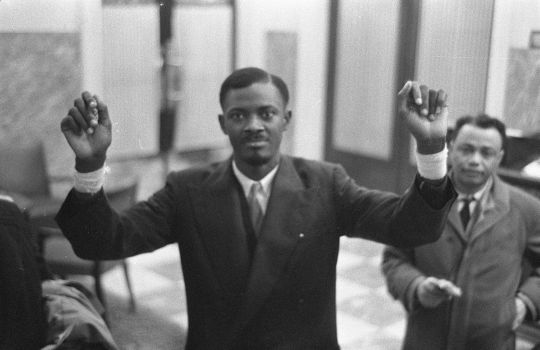
Congolese leader Patrice Lumumba in Brussels, Belgium, in January 1960. Wikimedia Commons
Patrice Lumumba was a radical leader of the Congolese independence movement who resisted Belgian colonialism and corporate interests. That’s why he was assassinated in a US-backed coup 59 years ago today.
Born in 1925, Patrice Émery Lumumba was a radical anticolonial leader who became the first prime minister of the newly independent Congo at the age of thirty-five. Seven months into his term, on January 17, 1961, he was assassinated.
Lumumba had become an opponent of Belgian racism after being jailed in 1957 on trumped-up charges by the colonial authorities. Following a twelve-month prison term, he found a job as a beer salesman, during which time he developed his oratory skills and increasingly embraced the view that Congo’s vast mineral wealth should benefit the Congolese people rather than foreign corporate interests.
Lumumba’s political horizons extended far beyond the Congo. He was soon caught up in the wider wave of African nationalism sweeping the continent. In December 1958, Ghanaian president Kwame Nkrumah invited Lumumba to attend the anti-colonial All African People’s Conference, which attracted civic associations, unions, and other popular organizations.
Two years later, following mass demands for a democratic election, the Congolese National Movement headed by Lumumba decisively won the Congo’s first parliamentary contest. The left-nationalist leader took office in June 1960.
But Lumumba’s progressive-populist proposals and his opposition to the Katanga secessionist movement (which was led by the white-ruled colonial states of southern Africa and proclaimed its independence from the Congo on July 11, 1960) angered an array of foreign and local interests: the Belgian colonial state, companies extracting the Congo’s mineral resources, and, of course, the leaders of white-ruled southern African states. As tensions grew, the United Nations rejected Lumumba’s request for support. He decided to call for Soviet military assistance to quell the burgeoning Congo Crisis brought about by the Belgian-supported secessionists. That proved to be the last straw.
Lumumba was seized, tortured, and executed in a coup supported by the Belgian authorities, the United States, and the United Nations. With Lumumba’s assassination died a part of the dream of a united, democratic, ethnically pluralist, and pan-Africanist Congo.
The murder of Lumumba and his replacement by the US-backed dictator Mobutu Sese Seko laid the foundation for the decades of internal strife, dictatorship, and economic decline that have marked postcolonial Congo. The destabilization of Congolese society under Mobutu’s brutal rule — lasting from 1965 to 1997 — culminated in a series of devastating conflicts, known as the first and second Congo wars (or “Africa’s world wars”). These conflicts not only fractured Congolese society but also engulfed nearly all of the country’s neighbors, ultimately involving nine African nations and around twenty-five armed groups. By the formal end of the conflict, around 2003, nearly 5.4 million people had died from the fighting and its aftermath, making the war the world’s second deadliest conflict since World War II.
Particularly in light of the Congo’s turbulent trajectory following his assassination, Lumumba remains a source of despair, debate, and inspiration among radical movements and thinkers across Africa and beyond. Jacobin contributor Sa’eed Husaini recently spoke with Georges Nzongola-Ntalaja, a leading Congolese intellectual and the author of a biography of Lumumba, about the life, death, and politics of the radical nationalist leader.
SH | Arguably the best-known event of Lumumba’s life remains its tragic end. Though there has been at least some symbolic acknowledgment of Belgium’s role in Lumumba’s murder, no such reckoning has occurred in the United States. From your perspective, what would a full restitution for Lumumba’s murder look like?
GNN | There cannot be a full restitution for Lumumba’s murder. No amount of money or other form of compensation would do justice to the harm suffered by the Congo in losing a thirty-five-year-old visionary leader who could have helped build a great country. No amount of money would do justice to his children after having grown up without a loving and supporting father to guide them through childhood, adolescence, and young adulthood. And the same goes for his wife and other relatives, whose loss could not be mitigated by material acquisitions.
What is needed from all the accomplices in Lumumba’s murder is, first of all, an acknowledgment of the crime they committed against him, his family, the Congo, and Africa; an apology for the harm done in this regard; and an effort to honor the Congo’s first democratically elected leader by promoting his legacy through schools, public education, and cultural events in all the countries whose leaders took part in his disappearance, beginning with the Congo itself.
SH | Despite growing up in his ethno-cultural homeland, Lumumba came to be known for his ardently multiethnic and even pan-African worldview. Were there aspects of his early upbringing in Sankuru that predisposed Lumumba to place a high value on Congolese unity and ethnic diversity?
GNN | While the Sankuru region of the DRC (Democratic Republic of the Congo) is mostly known as the home of the Tetela people, to which Lumumba himself belongs, it is inhabited by people of other ethnic groups who ended up there either because of the activities of the Swahili-Arab slave traders or those of Belgian colonialists. These groups include the Kusu of Maniema, the Luba, the Songye, and other groups from the Kasai region, as well as the Mongo of Équateur.
In addition to growing up in a multiethnic environment, Lumumba’s formative years as a middle-class civil servant took place between 1944 and 1956 in Kisangani (then Stanleyville), one of the major cities in the Congo and an area of ethnic diversity.
SH | You write that as a postal official in the Belgian colonial service, Lumumba was initially enamored by the possibility of “matriculating” or dropping his status as a “native” Congolese in favor of the status of an évolué, or honorary European. At what point did Lumumba abandon this hope of attaining elite status in colonial society in favor of a radical opposition to the Belgian colonial project?
GNN | Lumumba acquired both the civic merit card and the matriculation status in Kisangani, but these achievements of upper mobility in the colonial situation were a sham because racism continued to raise its ugly head through the color/wage bar.
Although entrusted with a job usually reserved for Europeans as manager of the money orders service, Lumumba’s salary was determined by his race, not his functions. He earned the equivalent of $100 USD in 1956, somewhere between one-tenth and one-fifteenth of the salary of a European civil servant doing a similar job. His European colleagues also received free housing, a car, and a fully paid, six-month vacation back home to Belgium every three years.
These and other realities of the colonial situation eventually made him abandon his naive hope of seeing whites and the évolués working hand in hand to lift up the “ignorant masses” in a Belgian-Congolese community and pushed him in the direction of African and Congolese nationalism.
SH | How did Congolese nationalists view violence as a means of attaining political independence, and where did Lumumba stand on this question?
GNN | In general, Congolese nationalist leaders were strong believers in nonviolence, and Lumumba was no exception. This is why they were all shocked by the mass uprising for independence on January 4, 1959 [which erupted in Leopoldville, present-day Kinshasa, after members of an anticolonial party were denied the right to assemble. Celebrated today as the Day of Martyrs, it was the first major outbreak of violence in the independence movement and marked a turning point for the anti-colonial struggle].
Later on, these leaders understood that mass violence was a bargaining chip in their confrontations with the colonial masters, as the latter found it difficult to maintain law and order in the vast Congo once the masses had rejected colonial authority and were unwilling to obey colonial administrative directives.
SH | What role did international mining companies play in encouraging the province of Katanga to secede from the Congo, and how did this contribute to the origin of the Congo Crisis?
GNN | With their mineral empire running from Katanga to the Cape, international mining companies did not like the idea of having a radical nationalist government in the Congo — one likely to reduce their profit margins with higher taxes and royalties in order to improve the livelihood of ordinary Congolese. This is why these companies, which had rejected efforts by white settlers to get a piece of the pie as their counterparts in South Africa, Rhodesia (Zimbabwe), and South West Africa (Namibia) had done, switched gears by forming an alliance with racist white settlers and right-wing lobbies in the United States and the United Kingdom.
This alliance not only endorsed the long-held dream of white settlers to gain political power in Katanga, but also provided the funds needed to sustain the secessionist drive in Katanga, with help from Belgium, Britain, and France.
SH | One could say that the origins of the Congo Crisis lie in a chance alliance between Belgian settlers and corporations, uniting with business and state interests from the white-ruled states of southern Africa. You describe this alliance as a “counter-revolution against national liberation,” given that it was formed to oppose the radical nationalism sweeping the continent. Could you say more about this alliance?
GNN | The Congo Crisis cannot be understood without reference to the Belgian-engineered Katanga secession in collaboration with international mining companies, which recruited white mercenaries to join Belgian troops in backstopping the secession. The UN refusal to use force to expel Belgian troops and the mercenaries led to the dispute between Prime Minister Lumumba and UN secretary-general Dag Hammarskjöld, who shared the same worldview as major Western powers and was very hostile toward Lumumba, as shown by the cable traffic in UN archives.
SH | So why did this combination of previously competing international and local actors ultimately come to agree that Lumumba’s assassination was necessary?
He was the single most important obstacle to their scheme of establishing neocolonialism in the Congo, as they started on July 11, 1960 in Katanga.
SH | Lumumba delivered many memorable speeches and also wrote many moving letters. In 1960, he wrote to his wife from prison: “The day will come when history will speak. But it will not be the history which will be taught in Brussels, Paris, Washington or the United Nations. It will be the history which will be taught in the countries which have won freedom from colonialism and its puppets. Africa will write its own history and in both north and south it will be a history of glory and dignity.” Was Lumumba also able to articulate a specific vision for how he intended to transform the state and Congolese society during the brief period in which he served as prime minister?
GNN | We do get a glimpse of his vision for postcolonial Congo in several of his major speeches and letters. While preoccupied with the unity, independence, and sovereignty of the Congo, due of course to the counterrevolutionary situation facing the country from July 10 to 11, 1960 (the Belgian military invasion and the Katanga secession, respectively), his main concern was how to transform the inherited structures of the state and the economy in order to improve the quality of life of ordinary Congolese.
SH | Like Amílcar Cabral, Thomas Sankara, and Steve Biko, Lumumba’s martyrdom transformed him into a powerful symbolic force that continues to inspire radical movements across Africa. In your preface, you briefly describe the inspiration and sudden disappointment you felt at the time as a high school student (who was expelled for anti-colonial activities) witnessing Lumumba’s meteoric rise and tragic assassination. As Africans and in the wider world, have we truly reckoned with the historical trauma that came from witnessing the assassination of some of the continent’s most promising leaders?
GNN | Since all the assassinated leaders you mention were victims of world powers and/or their allies in Africa, like fascist Portugal and apartheid South Africa, I don’t see why the world powers responsible for eliminating those African leaders they detest should be concerned with the impact of those assassinations on Africa.
It is up to us, Africans, to make sure that we follow the teachings of Amílcar Cabral on knowing our own weaknesses and finding ways to overcome them, and those of Kwame Nkrumah on collective continental security through an African military high command. We need our own equivalent to NATO to ensure the security of our people and that of our endangered progressive leaders.
Source: Jacobin Mag
0 notes
Text
Know all facts: Why should we hire MEAN Stack Developers from India
The MEAN Stack Developer is highly favorable in future programming with Full-stack JavaScript development where technology drives easier and simpler way to build the feature-rich applications. Mean Stack is the best and most efficient contemporary technology.
The MEAN Stack is a collaboration of four most proficient JavaScript-based technology platform, which is widely used for building web applications and JavaScript development. MEAN is the new go-to technology in the enterprise market, exclusively for those who are targeting towards providing reliable, responsive and scalable web apps. MEAN Stack, being one of the fastest growing open source development framework helps developers with popular tools and reduces the time they spend on system administration and It’ allows the quicker deployment of web applications, websites and API’s. MEAN Stack helps developers to concentrate on development.

MEAN Stands for
M – Mongo DB (database system)
E – Express (back-end framework)
A – Angular.js (front-end framework)
N – Node.js (back-end runtime environment)
The four platforms put together with help create an environment that has beautifully and efficiently designed front end and back end, synced to perfection, and stored in a database that vastly improves the functionality of your website or app. And all that done in a fraction of the lines of code usual developers would have to write.
Reasons to Choose Mean Stack Developer is free, open source and reliable framework
for web and app development. Mean Stack gives you code reusability and flexible environment. MEAN a Stack is a Perfect tool for full-stack web development with the front-end and backend processing.
Advantages of MEAN Stack Developer
Possible To Switch Easily Between Server And Client
Enterprise Focus
Rapid Application Development & Test Flight enabled Release Process
Unique Solutions with no Jailbreaking code
Performance Oriented Robust Apps
Scalable Architecture
One Stop Solution
Why Choose Hire Mean Stack Developer in India Rather Than other Country:-
There are many reasons behind to choose or Hire the MEAN Stack Developer from India than anywhere.The cost of Hire MEAN Stack Developers is more affordable than another country
Indian developer has more capabilities to provide efficient solutions with High ROI
They are more talented and able to work under pressure
They can provide easy development solutions under the timeline
They provide a monthly and weekly report
They are always updated with new and latest technology
Are you worried about Hire a MEAN Stack Developer from India or have a question in mind, where you can hire best MEAN Stack Developers team in India?
No need to be panic, here I would like to suggest HourlyDeveloper.io as one of the best and expert teams of MEAN Stack Developers.
HourlyDeveloper.io has over the years made a name for itself as one of the top web and mobile app and Software Development Companies in India. The team has a passion for everything design and development and they believe that this combination of the two is what sets us apart from the rest. As a company that is always looking for new walls to break, they know that their work with MEAN Stack has resulted in some of the most groundbreaking products for its clients around the world.
Their vision is to be trusted & respected as a world-class Mean Stack development company in delivering and developing state-of-the-art, innovative IT solutions for their clients to improve profits as well as build efficiency. Their mission is to constantly grow as a professional IT solutions company and support their clients and partners with cutting-edge website design and development solutions and services that allow them ultimately to innovate, create and profit.
For More information visit - https://bit.ly/2PuqFDP
Connect with an expert - https://bit.ly/2I5tYkB
Or Write – [email protected]
0 notes
Text
Eating the Forbidden Apple or My Switch to Snowboarding at 31

I already know how to ski.
That was the main reason I never spent more than part of a run snowboarding in the 11 seasons I spent skiing. Skiing took me anywhere I wanted to go. It was the ultimate form of consumption. Pop. Set. Grab. Four point. After a few thousand turns under the night lights of Michigan's ski hills, skiing was hard wired into my reptilian brain.
I stopped worrying about how I was getting places and just started going. I heard there were mountains in Montana so when I found out school was cheaper there after a year of residency I made the switch without ever visiting. I had seen the mountains in videos. I was ready to live that life.
The funny thing about living in the mountains is that when you learn to live in them, it's easy to stay above the riff-raff. I'd have my moments poking my head into those heavenly clouds only to point my tips straight back down.
It wasn't the turn I sought after, rather the change.
Here. There. Black. White. On. Off. Exercise at sun rise, if only to burn off all of the sex drugs and rock and roll the night before.
The whole time, all around me, there were snowboarders. On the mountains, in my classes, where I worked. There were times when they wouldn't go the ways I wanted to, riding or not, and I always thought it was because they lacked the mental fortitude and commitment it took to barrel blindly down the hill with me. I always knew my skills and my equipment would get me through whatever I encountered. My reptilian brain was amazing. I assumed theirs was as well.
“Same thing just different,” I'd always think to myself, imaging each turn in any direction on a snowboard to be just the same as skiing. “I don't need to, because I already know how to ski.”
But I'd spent enough time on skis that I wasn't really skiing anymore. I was just going places on my skis. I had no plans to change, and then one crushed pelvis/spine and wobbly hip joint later, skiing 's been out of the picture for the last two winters, and the next few for sure. As a method of easing myself back into the world, I went full fledged into powder surfing (I'd played with it the previous two winters).
When I first started powder surfing, I treated it just like skiing. See a place and go there. The surfboards I made were based off of my understanding of how a ski boot drives a modern pow ski. The kick tail at the and of the rocker was based off of how fun it was to do pow manuals on a ski, and also how that was an effective method for speed control on straight lines. The elevation curve matched the only place I knew side cut would be used. The shape profile was based off making an easy swiveling ski.
And so I bombed down the hill, over time, slowly picking up my boards tendencies to climb back up hill. I was just excited about the maneuverability and increased reach on my lines. Although at the end of a couple of winters shaping I had all of the right shapes to ride a wave, I lacked the knowledge of feel for riding bigger and more graceful lines.
And then summer came and I decided to learn how to skateboard. I was 30, turning 31, and still pushing mongo. I watched a youtube video by a guy named Sergio Yuppie about his rise to success sliding a skateboard downhill in Brazil. He said that skateboarding taught him respect, and that although downhill slide was his core, he loved and respected all styles. I realized that if I was going to start taking powder surfing seriously, I'd have to learn all sorts of boarding. I wasn't sure how I was going to learn respect, but then it came.
It came in the early morning hours when I could go to the skatepark while it wasn't crowded, so I could take up space with my awkward learning. That came from the kids. None of them ever said a cruel word to me within earshot.
They would quit skating and sit off to the side of the park without making eye contact if I was being to clumsy. As much as I was trying my hardest, they were too. And the more confident kids did there best to be creative about letting me know when I wasn't welcome. One hot summer day no less than four kids less than half my age all did the move I was trying for 10 minutes right in front of me. All in a row.
I couldn't help but smile and skate off. If I was cooler I would have learned how to play with them, but I wasn't there yet. Every day I got better at skateboarding was still a day that I was still worse than people half my age. But it didn't matter because I was getting better.
By the end of the summer, after I could ride all the transitions and learned to stay out of people’s way without causing too much of a scene, I even got a few nods. And I’ve never been happier about something so small. The sun only stays up for so long. There’s only so much time to skate. Being welcome on any level into the free time of strangers whether skateboarding or playing baseball takes a lot of understanding, skill, or good nature.
In developing the needed skills, I learned good nature through humility. Nobody cares that you skateboard. Nobody cared when they started either. If they got better it was because they crashed. If you crash you just get laughed at. And maybe you should get laughed at, you’re the one who just wrecked on a skateboard.
After a summer skateboarding I wasn't prepared for the snow to fall.
And when it did my first five feet on one of my surf boards was better than all of the ones before—my time spent riding a board a new way gave me a new perspective and confidence. I still remember the thoughts running through my head as I rushed forward over a dusting of snow on grass.
“If it takes that much to flip a board balanced on four tiny wheels, there's almost nothing to be afraid of.”
It's true. With reckless confidence, it doesn't take extraordinary skill to slide straight downhill on any board on almost any surface, solid or otherwise. With the proper boots on, it's possible to skip the body english required to turn a single board, and instead efficiently manage two. Modern ski shapes/construction make the boot/ski interface as effective as a joystick at an arcade. With chairlifts powering every turn, repetition became the name of the game. I made good turns, because statistically, I'd made enough bad ones to discover the feeling of a good one, and though the first one may have come unnoticed mid-run, the law of averages meant that after enough turns, I'd make more good ones than bad.
On the other hand, the lack of recklessness surfing the snow brought me—with no chair lift every ride was cherished—immediately defined the attraction to skateboarding for me. Sure I could try something new on a skateboard, but that meant I had to be able to walk away from it if I made a mistake.
Falling on a skateboard is terrible. Asphalt is not my friend. To try something new on a skateboard meant risking my skin. But after I gained the ability to skateboard down a sloped parking lot, I saw my own ability to improve.
6 months of skating every day left me making more turns than I ever imagined, and I'd only imagined to get all four wheels off the ground once. Instead I'd learned to explore the world around me without leaving it. Long runs down hills making turns transformed my small town into a ski area.
But it wasn't just the streets. The steep slabs and curved concrete of the skate park drew me in. Fixed frozen waves I began working on turning my board all ways on the wave. It's all moves I would have figured out as a kid if I didn't roller blade or bike everywhere I could have just skated. Instead I saw skateboarding as a version of what I wanted to do, not an extension of something before me.
In fact, I always saw surfing as something separate. Growing up without waves in the state of Arizona Skateboarding only came to me through the internet in its infancy, and CCS mail-order catalogues. I spent hours pondering decks I'd never own never even thinking of how to use them. I never understood that each skateboard move is a continuation of a move done on water.
Moves first made hundreds of years ago all over the world. Moves that only change in style, but not function. When riding a surface of any sort, the same set of physics applies. The style in which they are used changes, but once the physics are learned, each board becomes a way to interpret them.
I didn't understand this until my legs started falling asleep from pushing and I had to switch styles.
That came from watching a video about a fence post getting turned into a street surfer.
The reviews said with Carver skateboard trucks like the ones attached to the fencepost, it was possible to pump just like on a surf board—even up hill!
I cut out my own surf skate deck from one of my blemished powder surfers and set off into the city sidewalks. The ability to carve turns on wheels instead of slide through them making the traditional skrrrrrrttttttt sound while shedding speed blew my mind. At first it was because I lacked the coordination required to slide to a stop, and instead I could make a series of quick turns to make a stop.
I didn't know it, but I was being introduced slowly to the lateral travel that makes surfing more than just sliding down the face of a wave. All I saw was a looser x-axis for controls that allowed for an intuitive combination of manually pointing the front end of the board where I wanted it to go and leaning, very opposite of the normal skateboards I was used to that required first a lean, and then either lifting the front wheels or sliding or both for major changes in direction. Sudden stops on a skateboard are called a power slides. There are no sudden stops on a wave, but it is possible to shift your velocity in a given direction another very suddenly.
It's this experiment in sudden change in inertia that makes surfing special no matter what medium it happens on. The simple reminder that everything, everything, is just a wave of energy suspended at different speeds.
There, balanced between being and not being, is where the conscious choice to make a turn or not takes place. How we make those turns, if we choose to make them at all, is up to us. Everything that is existence is already in motion. Waves on water are just natures way of making visible to us the medium we actually inhabit.
Energy.
This was NOT how I was familiar my reptilian brain thinking.
Hell, at this point it wasn't even my brain thinking. It was allowing the world around me to exist and then adapting to it, in a style that's been around for hundreds of years if not longer. The thinking done by the folks at Carver for riding waves immediately started translating into how I saw the streets and the skatepark, and soon steep hills became stacks of manageable waves I could play on instead of race down. Less steep hills became one big wave with bottom turns, top turns, and cut backs. I started seeing sliding on a skateboard as the same thing on a snowboard. Going down the hill, but not gracefully.
Level ground became everything but. Everything can be surfed if it's looked at the right way.
And so after six months of skateboarding and a few powder surfing trips, I traded a board I made for a discount on a board from Elevated Surfcraft. The past two winters without chairlift rides due to my inability to ski were enough. Snowboarding would be just like powder surfing and skateboarding and surfing.
Surfing. That was the key. If I'd learned anything from my summer skating, it's that I wanted a directional board. And I wanted to surf. That focus is what makes riding wheels fun for me. The all new way to interact with my environment. Throwing a turn in an unconventional place became as exciting as any extreme move I'd ever pulled, even if it was just a turn.
I was so ready to be as bored of snowboarding as I was of skiing. My first chair lift ride I watched as the mob of people sped below me flat based down the groomer face. I'd gone down the same runs on my skis backwards without turning as a kid, so I wasn't totally terrified going up. I'd already conquered the bunny hill too, so this was the same thing, just steeper I thought.
And soaked in sweat at the end my first blue run I thought I was right.
It wasn't until a week later, when I finally got to ride powder at Michigan's Mount Bohemia, a place notorious for stranding beginning snowboarders did I finally feel the light.
In the that first day, through the trees, over rocks, with powder up to my knees, Bohemia's steep faces and rowdy ridges became one big beautiful right. And after a few waves I worked up enough courage to ride some lefts. By the end of the day I could ride both indiscriminately, always taking the high line over the tracks of skiers and snowboarders alike through nearly un-reachable powder with ease.
It was the first time I'd ridden at speed since my accident, and by the end of the day I felt fresh. Surfing the most pleasant line through the rowdiest places is a gentle way to go about life, and I like it.
Ok. Powder snowboarding was cool. But I still like surfing when I can.
And then the temps fell, but that was it. Back to the groomers.
Back to the groomers.
For five or six days I showed up at the ski hill just long enough to get a few laps in. Groomers. Groomers and some stashes that were supposed to be closed.
But groomers. On a board that was mostly meant for powder, but I'd seen carved. I kept trying to carve, but it was hard. There's a lot of blind faith in turning back side, and because I was on a directional board, a lot more movement makes the turn, so it made riding groomers a sort of annoying necessity.
Until I did enough back side turns in powder to understand their appeal. Blind faith when executed properly is a beautiful thing. It's trusting a form that's been there since people started sliding sideways regardless of where or how. It's universal, more so than any dance move, because it moves to the ever present waves of energy, you just have to be patient enough to feel the rhythm.
Fortunately for me, falling on soft snow made me comfortable enough to try it elsewhere. It's something like this I probably wouldn't have worried about as a kid, but now makes me ever grateful.
Seeing the world on edge, instead of positioned between two sliding surfaces, allows for an entirely new perspective on the environment. The ability to turn on a dime, just like on a surfboard or a skateboard and change your inertia the complete opposite direction with relative grace is a move at the very abstract of skiing, requiring a special course, giant/steep spaces, and/or incredible boot fit. On a snowboard, only takes an imagination and confidence. The kind similar to what comes from learning how to jump a bicycle, but from a much deeper, more thought out pool of knowledge. As a species, we’ve been sliding sideways longer.
It's hard to see snowboarding as any different than skiing as a skier. They still do the same thing just different. But if you want to understand snowboarding as everybody else, the best way to start is to look to surfing. If you want to be thankful, as you should be, snowboarding is the combination of so many ideas that have nothing to do with skiing, so maybe, if you want to be thankful, learn how to skate, but don't ever forget to surf.
As for eating the apple, talking about it any further is probably copyright infringement, I have faith in that.
0 notes
Text
y’all i’m looking for this video of young Sage back in 2011 where he was just ollieing over stuff and pushing switch mongo but already had mad style. i posted it on the blog when i first started it, but it seems to have vanished from youtube. has anyone seen it somewhere?
2 notes
·
View notes
Text
Linux Download Docker

March 2, 2020 by Matt Hernandez, @fiveisprime
When the command is invoked, docker contacts Docker hub and downloads a docker image called ‘hello-world’. Docker then creates a new container that runs the executable script that streams the message ‘ Hello from Docker! To download or pull an image from Docker hub without running it, use the syntax: $ sudo docker pull. The Linux NAS distribution (Debian based) Open Media Vault (OMV) has an UrBackup server plugin starting with OMV 3.0 in OMV-extras. Starting with OMV 5.0 use the Docker container below. ASUSTOR - ASUS NAS.
Last June, the Docker team announced that they will be investing in getting Docker running with the Windows Subsystem for Linux (WSL). All of this is made possible with the recent changes to the architecture of WSL to run within a lightweight virtual machine (VM), which we talked about in an earlier blog post about WSL 2. Since this announcement, the Docker team has released a Technical Preview of Docker that includes support for running with WSL 2.
This article explains how the Docker Desktop technical preview works as well as how to use the Docker extension with the technical preview.
How it works
This new Docker architecture works a lot like Visual Studio Code's WSL remote development support in that the Docker CLI running on the host machine executes commands within the Docker Integration Package, which runs on the remote WSL VM.
Image credit: Docker Engineering
DockerD runs directly within WSL so there's no need for the Hyper-V VM and all Linux containers run within the Linux userspace on Windows for improved performance and compatibility.
Getting set up
First some prerequisites:
Jul 05, 2018 Docker is an application that simplifies the process of managing application processes in containers. In this tutorial, you'll install and use Docker Community Edition (CE) on Ubuntu 18.04. Docker upgrade ubuntu. Nov 07, 2019 When running docker desktop version 2.1.5.0 (40323) on: OS Name: Microsoft Windows 10 Pro OS Version: 10.0.19013 N/A Build 19013 Eben though WSL 2 based engine is enabled in Settings/General docker container run hello-world on Ubuntu rep.
Install Windows 10 Insider Preview build 18975 (Slow) or later for WSL 2.
Install Ubuntu from the Microsoft store.
Enable WSL 2 by following this guide.
Install the Remote - WSL extension for VS Code.
Install the Docker WSL 2 Technical Preview.
Once installed, Docker will recognize that you have WSL installed and prompt to enable WSL integration. You want to Enable WSL integration for this tutorial.
This option will allow you to access Docker Desktop via the Docker CLI directly from within your Linux distro.
If you have multiple Linux distros, make sure you only have WSL integration turned on for the correct one in your Docker settings:
With that configured, all commands will execute in the Linux context - this includes Docker commands run from PowerShell so running something like docker run mongo… will start a Linux container within the WSL VM.
Running the docker ps command over in WSL, you'll see the container as expected. Notice that the container ID matches.
Using VS Code
With this set up and running, you can install the VS Code Docker extension and access your containers. If you're already running WSL 2 and the Remote - WSL extension, this will help you get Docker integrated into your WSL workflow rather than switching contexts when you need containers. And because the Docker CLI's context is set to use DockerD in WSL, the extension will work with your containers regardless of whether you opened VS Code using the Remote - WSL extension.
Notice how in the screenshot below, I'm connected and working in WSL and still building/running containers without changing from my preferred environment (zsh in Ubuntu).
Theme: Noctis Sereno
I've personally noticed a vast improvement in container execution times using this configuration and each part of my typical development workflow remains the same. I'm also using the Remote - Containers extension within WSL for testing specific environments without setting things up directly on my machine.
We want your feedback
Keep in mind that you're using prerelease software and, while the Windows Insiders Slow ring is very stable, you may run into some issues. If you do find something that isn't working as expected, please open an issue via the Feedback tool in Windows. Any direct Docker issues or feedback can be logged in the Docker for Windows repo.
Happy Coding!
Matt Hernandez, VS Code Program Manager @fiveisprime
Estimated reading time: 7 minutes
You can run Compose on macOS, Windows, and 64-bit Linux.
Prerequisites
Docker Compose relies on Docker Engine for any meaningful work, so make sure youhave Docker Engine installed either locally or remote, depending on your setup.
https://huntercountry477.tumblr.com/post/653677848988729344/catalina-dmg. On desktop systems like Docker Desktop for Mac and Windows, Docker Compose isincluded as part of those desktop installs.
On Linux systems, first install theDocker Enginefor your OS as described on the Get Docker page, then come back here forinstructions on installing Compose onLinux systems.
To run Compose as a non-root user, see Manage Docker as a non-root user.
Install Compose
Follow the instructions below to install Compose on Mac, Windows, Windows Server2016, or Linux systems, or find out about alternatives like using the pipPython package manager or installing Compose as a container.
Install a different version
The instructions below outline installation of the current stable release(v1.28.6) of Compose. To install a different version ofCompose, replace the given release number with the one that you want. Composereleases are also listed and available for direct download on theCompose repository release page on GitHub.To install a pre-release of Compose, refer to the install pre-release buildssection.
Install Compose on macOS
Docker Desktop for Mac includes Compose alongwith other Docker apps, so Mac users do not need to install Compose separately.For installation instructions, see Install Docker Desktop on Mac.
Install Compose on Windows desktop systems
Docker Desktop for Windows includes Composealong with other Docker apps, so most Windows users do not need toinstall Compose separately. For install instructions, see Install Docker Desktop on Windows.
If you are running the Docker daemon and client directly on MicrosoftWindows Server, follow the instructions in the Windows Server tab.
Install Compose on Windows Server
Follow these instructions if you are running the Docker daemon and client directlyon Microsoft Windows Server and want to install Docker Compose.
Start an “elevated” PowerShell (run it as administrator).Search for PowerShell, right-click, and chooseRun as administrator. When asked if you want to allow this appto make changes to your device, click Yes.
In PowerShell, since GitHub now requires TLS1.2, run the following:
Then run the following command to download the current stable release ofCompose (v1.28.6):
Note: On Windows Server 2019, you can add the Compose executable to $Env:ProgramFilesDocker. Because this directory is registered in the system PATH, you can run the docker-compose --version command on the subsequent step with no additional configuration.
Test the installation.
Install Compose on Linux systems
On Linux, you can download the Docker Compose binary from theCompose repository release page on GitHub.Follow the instructions from the link, which involve running the curl commandin your terminal to download the binaries. These step-by-step instructions arealso included below.
For alpine, the following dependency packages are needed:py-pip, python3-dev, libffi-dev, openssl-dev, gcc, libc-dev, rust, cargo and make.
Run this command to download the current stable release of Docker Compose:
To install a different version of Compose, substitute 1.28.6with the version of Compose you want to use.
If you have problems installing with curl, seeAlternative Install Options tab above.
Apply executable permissions to the binary:
Note: If the command docker-compose fails after installation, check your path.You can also create a symbolic link to /usr/bin or any other directory in your path.

For example:
Optionally, install command completion for thebash and zsh shell.
Test the installation.
Linux Download Docker
Alternative install options
Install using pip
For alpine, the following dependency packages are needed:py-pip, python3-dev, libffi-dev, openssl-dev, gcc, libc-dev, rust, cargo, and make.
Compose can be installed frompypi using pip. If you installusing pip, we recommend that you use avirtualenv because many operatingsystems have python system packages that conflict with docker-composedependencies. See the virtualenvtutorial to getstarted.
If you are not using virtualenv,
pip version 6.0 or greater is required.
Install as a container
Compose can also be run inside a container, from a small bash script wrapper. Toinstall compose as a container run this command:
Install pre-release builds
If you’re interested in trying out a pre-release build, you can download releasecandidates from the Compose repository release page on GitHub.Follow the instructions from the link, which involves running the curl commandin your terminal to download the binaries.
Pre-releases built from the “master” branch are also available for download athttps://dl.bintray.com/docker-compose/master/.
Pre-release builds allow you to try out new features before they are released,but may be less stable.
Upgrading
If you’re upgrading from Compose 1.2 or earlier, remove ormigrate your existing containers after upgrading Compose. This is because, as ofversion 1.3, Compose uses Docker labels to keep track of containers, and yourcontainers need to be recreated to add the labels.
If Compose detects containers that were created without labels, it refusesto run, so that you don’t end up with two sets of them. If you want to keep usingyour existing containers (for example, because they have data volumes you wantto preserve), you can use Compose 1.5.x to migrate them with the followingcommand:
Alternatively, if you’re not worried about keeping them, you can remove them.Compose just creates new ones.
Uninstallation
To uninstall Docker Compose if you installed using curl:
To uninstall Docker Compose if you installed using pip:
Got a “Permission denied” error?
Docker For Linux Download
If you get a “Permission denied” error using either of the abovemethods, you probably do not have the proper permissions to removedocker-compose. To force the removal, prepend sudo to either of the abovecommands and run again.
Where to go next
Linux Download Docker-compose
compose, orchestration, install, installation, docker, documentation

0 notes